Canada
Country Overview
Canada is New Zealand’s 16th largest trading partner and our fastest growing export market. It has high rates of immigration in support of a booming tech sector.
Almost 40% of Canadians live in the cities of Toronto, Montreal and Vancouver, and the majority of the population lives within 150km of the US border. Thanks to the ease of setting up and doing business in Canada, it’s often used as a testing ground and launch pad for entry into the US market.
Canadians are generally knowledgeable and worldly consumers with his levels of income. Canada has a sophisticated food and beverage market, and a focus on quality and premium products.
Trade agreements
New Zealand and Canada were among the first six signatories to the Comprehensive and Progressive Agreement for Trans-Pacific Partnership (CPTPP) in 2018. This free trade agreement also includes Australia, Brunei, Chile, Japan, Malaysia, Mexico, Peru, Singapore and Viet Nam.
The CPTPP is one of the most extensive free trade agreements in the world. It provides enhanced market access to Canada for food and beverages and primary industries. It also offers duty-free access for wine, processed meats, wool, forestry and fisheries products. Beef tariffs and quotas are the next to be eliminated.
Country intelligence
The Robinson Country Intelligence Index is a holistic measurement of country-level risk and serves as an alternative measure of country development. It incorporates four broad dimensions of Governance, Economics, Operations and Society. A higher ranking indicates a better Country Intelligence Index score.

Value of New Zealand exports

International logistics performance
The International Logistics Performance Index measures how efficiently countries move goods across and within borders. Countries are ranked on their index score with a higher ranking indicating higher performance of trade logistics based on six components: customs, infrastructure, ease of international shipments, logistics services quality and competence, tracking and tracing, and timeliness.

Income and distribution of wealth
Global National Income (GNI) per capita is the dollar value of a country's final income in a year, divided by its population.
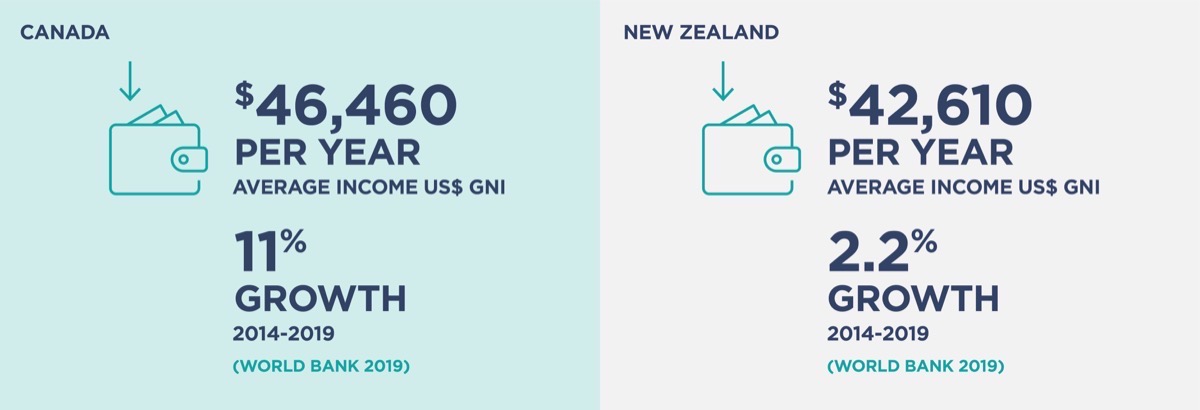
Annual Disposable Income refers to gross income minus social security contributions and income taxes. Each income band presents data referring to the percentage of households with a disposable income over that amount.
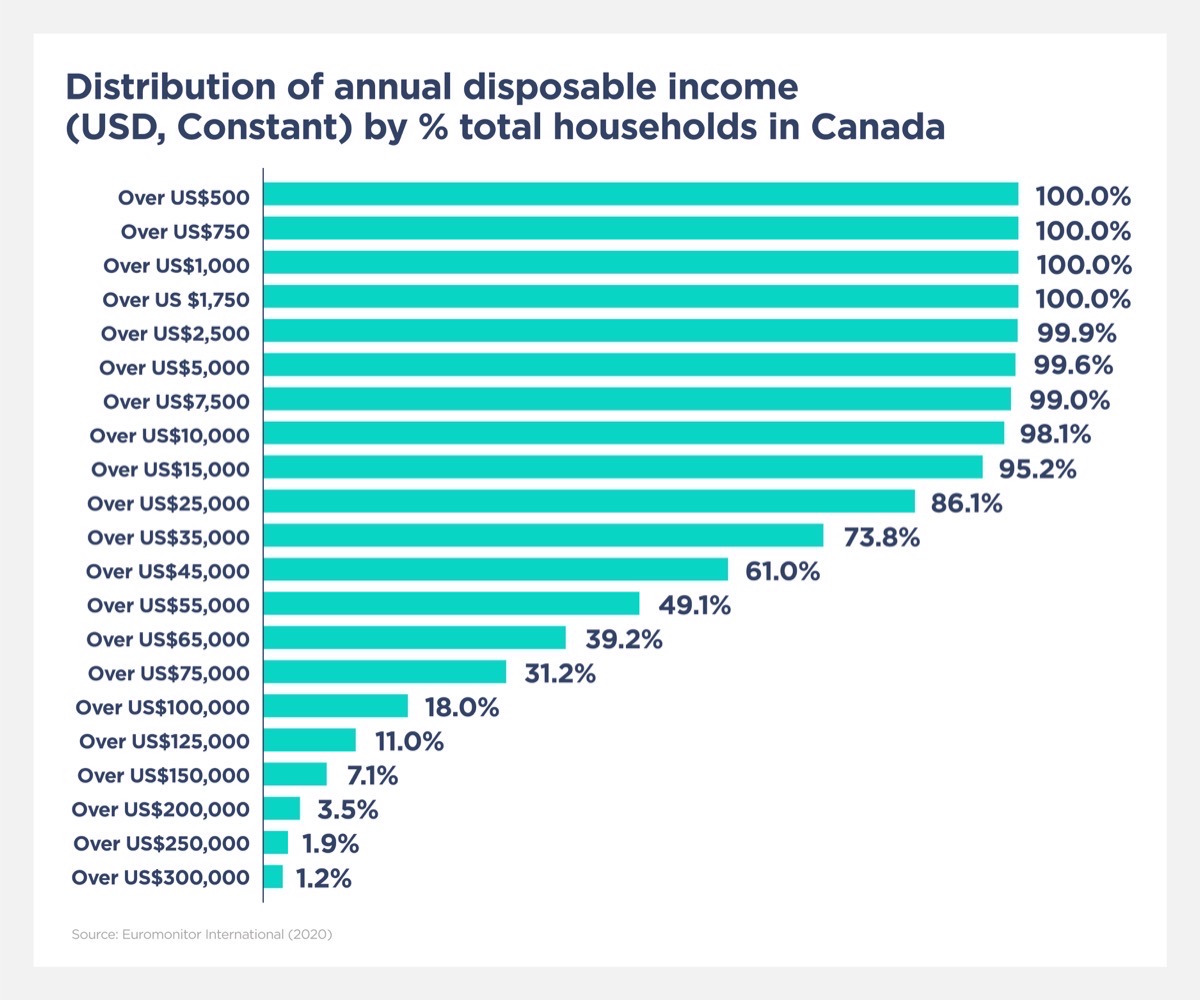
Further information
For more information to validate Canada as an export market, see our Canada Market Guide.
- Vitamins & Dietary Supplements
- Skin Care
- Dog & Cat Food
- Alcoholic Drinks
- Health & Wellness Packaged Food & Beverages
Vitamins & Dietary Supplements
- Market size and growth
-
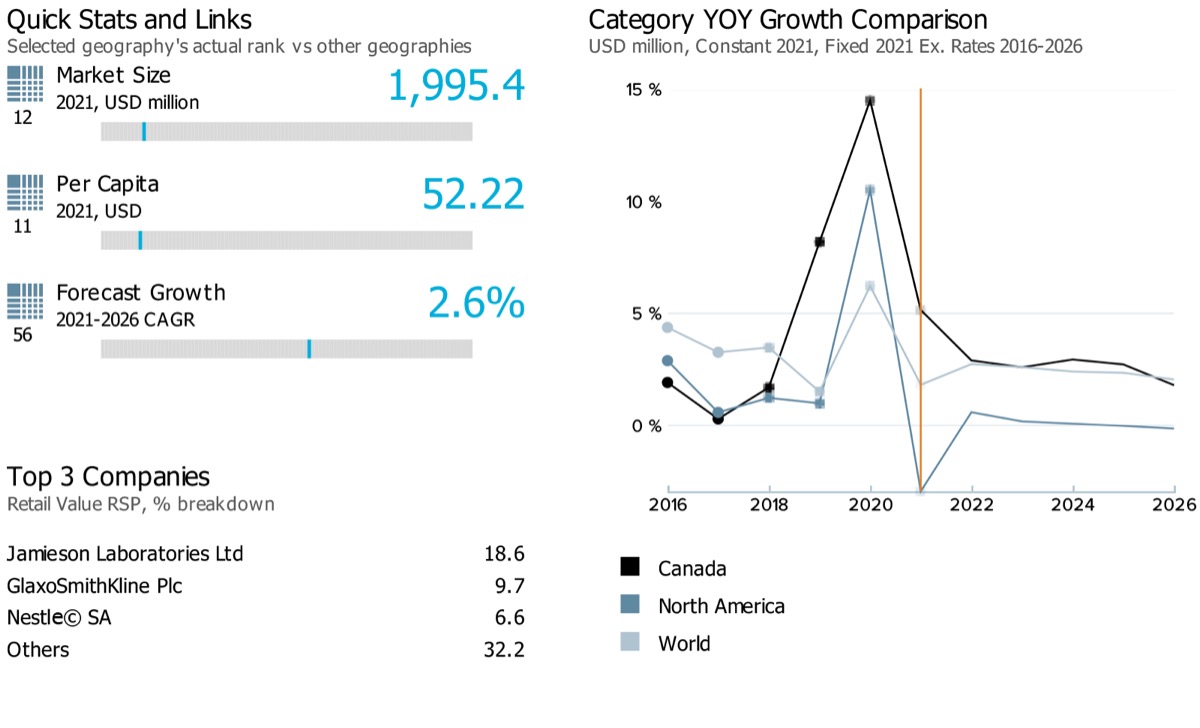
Note: Data on the top left corner of the image (12, 11 and 56) showcases respective ranks for Canada for its market size, per capita, and forecast growth rate compared against 99 countries globally. The blue line on the grey bar represents the relative position of the country as per their rank.
Note: Latest market size data for the year 2021 has been shared for Vitamins & Dietary Supplements
Canada's retail value sales of vitamins and dietary supplements witnessed a historic compound annual growth rate (CAGR) of 7.5% during 2016-2021. It is further expected to see a slowed down retail value CAGR of 2.6% over 2021-2026. The expected slowdown is mainly in line with the global performance of the category, where it witnessed a historic CAGR of 5.1% and an estimated slowdown for the forecast CAGR (2.4%) over the same period for its retail value sales.
- Sub-category breakdown
-
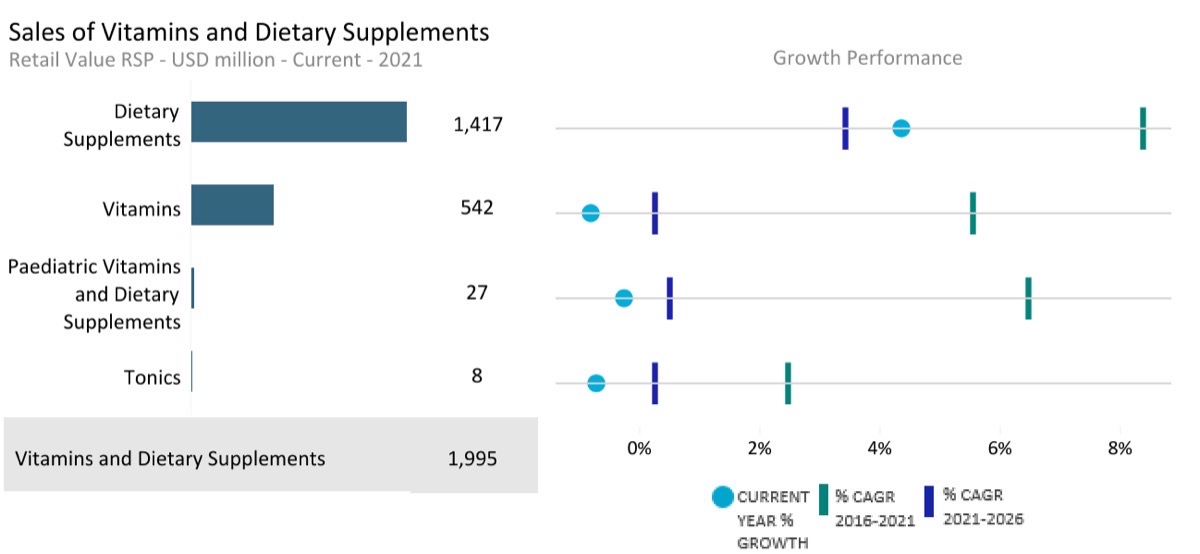
Note: Current year growth in the above chart refers to the period 2021-22
Category
Unit
Market size (2021)
Retail value RSP
Forecast compound annual growth rate (2021/2026) %
Vitamins and Dietary Supplements
USD million
1,995.39
2.55
Vitamins
USD million
542.34
0.25
Paediatric Vitamins and Dietary Supplements
USD million
27.49
0.49
Dietary Supplements
USD million
1,417.19
3.43
Tonics
USD million
8.37
0.24
- Channel distribution
-
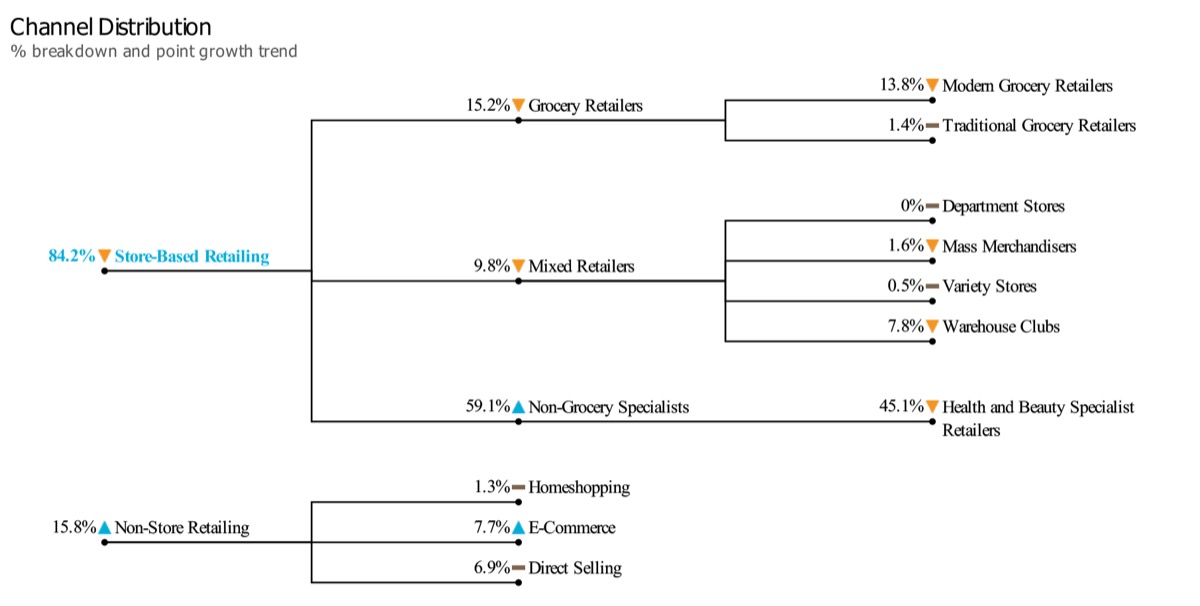
Note: The chart here showcases the retail value share of different channel sales for Vitamins and dietary supplement products in Canada in 2021. The triangle/dash represents whether the specific channel share has increased/decreased or remained the same against its share in the previous year.
- Market Insights
-
Market trends
- Vitamins witnessed an increase in retail value sales of 7.7% in 2020, in response to COVID-19, as many consumers turned to both multivitamins and single vitamins. All categories experienced strong growth, especially immunity-boosting vitamin C, vitamin D and vitamin A. Indeed, some types of vitamins experienced stockouts at retailers. For example, online health and wellness retailer Well.ca saw shortages of several popular Jamieson vitamins, including vitamin D, vitamin C and vitamin A, as well as Centrum Jr multivitamins. Apart from the rising health awareness in Canada, the performance of vitamins has been bolstered by the ageing of the population. According to Statistics Canada, 65% of women and 43% of men aged 51-70 years take nutritional supplements, including vitamins.
- In terms of specific brands, GlaxoSmithKline Consumer Healthcare, the recently formed joint venture between GlaxoSmithKline Plc and Pfizer, continues to lead vitamins sales thanks to the strength of its Centrum brand. Centrum enjoys high levels of recognition and trust among consumers and is widely available across Canada.
- On similar lines, dietary supplements experienced substantial growth with a 3.4% increase in retail value sales in 2020. The demand was boosted on account of the stockpiling behaviour by the consumers, followed by the rise in demand for immunity boosting and cold/flu fighting dietary supplements such as Echinacea and Ginseng. As with vitamins, population ageing will remain a key driver of demand for dietary supplements over the forecast period (2021-2026). This should strengthen interest in protein supplements, probiotic supplements, and fish oils/omega fatty acids, which are projected to be the three most dynamic categories in volume and current value growth terms. In terms of new product launches, OLLY, the fast-growing US-based premium gummy vitamins, and supplements brand owned by Unilever, was launched in Canada in 2020. The brand is available in retailers, including Walmart and Shoppers Drug Mart.
Prospects and growth opportunity
- Multivitamins is expected to remain the largest and most dynamic category in volume and current value sales terms over the forecast period (2021-2026). According to Statistics Canada, 23% of Canadians regularly take at least one multivitamin supplement daily. Vitamin D and C are expected to remain the most popular single vitamins categories in Canada over the forecast period, with both projected to register current value growth of 1.5% and 1.2% respectively. Private label penetration in vitamins will remain high in Canada over the forecast period. While private label lines primarily compete on price, they offer more sophisticated products formulated to provide optimum benefits for specific demographic groups; for example, Walmart’s Equate line offers Equate Multivitamin for Women and Equate Senior Women’s Multivitamin.
- Certain types of dietary supplements are facing competition from alternative consumer health products. For example, collagen supplements are competing against sports nutrition products such as Allmax Naturals Collagen Grass-Fed & Pasture Raised and BioSteel’s Natural Collagen Whey Protein. Similarly, protein supplements face a threat from supplement nutrition drinks (part of the weight management and wellbeing category), often favoured by older adults who have difficulty swallowing. Another challenge dietary supplements face is that rising health-consciousness leads more Canadians to choose natural fresh food or fortified/functional packaged food and beverages to improve their nutritional intake. Such increasing competition might represent a threat to further growth of dietary supplements in the country.
General health & wellness trends
- There has been growing consumer consciousness regarding the quality of the supplements they consume, and Covid-19 has only exacerbated this trend. In this context, the TRU-ID certification programme for authentication of active ingredients, developed at the University of Guelph, is gaining traction. Jamieson’s botanical supplements such as cranberry and lycopene include TRU-ID certification on product packaging and product information listed at Jamieson’s website. TRU-ID certificate uses DNA barcode testing to ensure the authenticity of botanical ingredients such as echinacea, cranberry and bacteria used in probiotics. This communicates the authenticity and quality of the product to consumers.
- Although e-commerce remains a minor distribution channel, online shopping is expected to play a more important role in dietary supplements than many other consumer health categories. Moreover, the channel’s value share continues to rise as more store-based retailers and manufacturers develop their online sales capabilities. Relatively high prices and the fact that the need for dietary supplements is rarely urgent make e-commerce a more viable option in this category. Genuine Health and Jamieson online stores offer free shipping on domestic orders over CAD75 and CAD25, respectively.
Skin Care
- Market size and growth
-
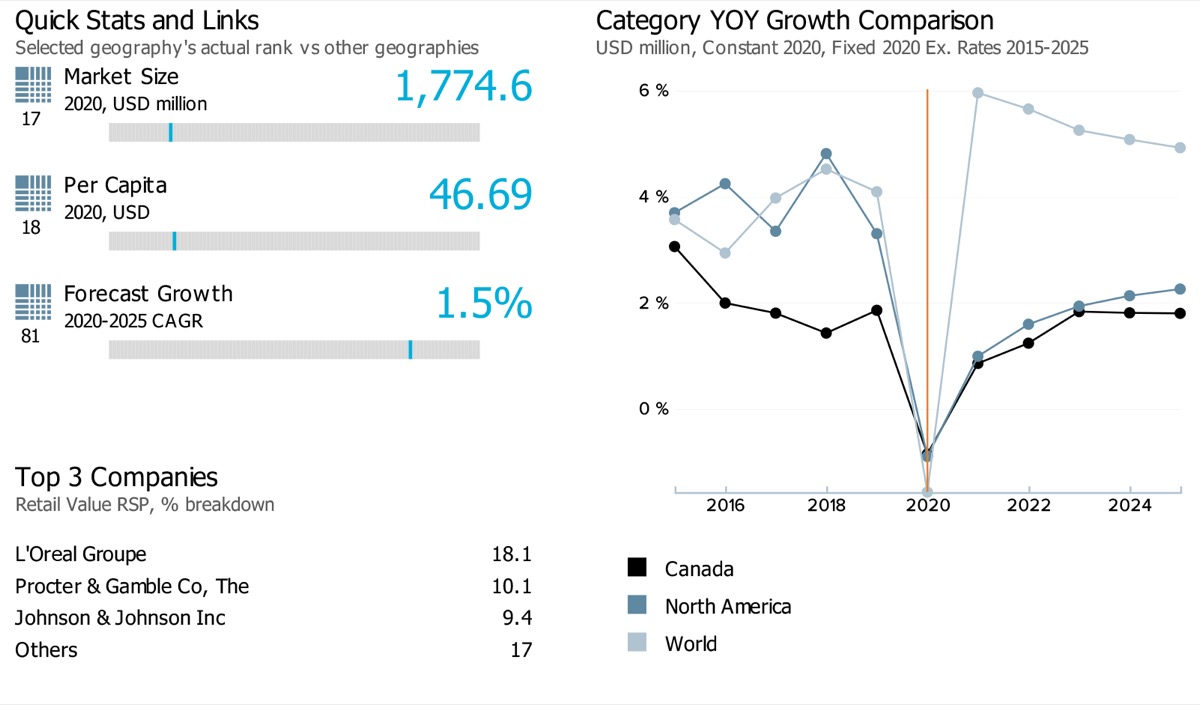
Note: Data on the top left corner of the image (17, 18 and 81) showcases respective ranks for Canada for its market size, per capita, and forecast growth rate compared against 99 countries globally. The blue line on the grey bar represents the relative position of the country as per their rank.
Retail value sales of skin care products in Canada witnessed a slower compound annual growth rate (CAGR) during 2015-2020 (2.8%) against the category’s performance at a global level (4.7%) during the same period. Even over the forecast period (2020-2025), the category is estimated to witness an increased CAGR of 5.3% at the global level, while in Canada, the category’s CAGR for the same period is estimated to slow down further and reach 1.5%.
- Sub-category breakdown
-
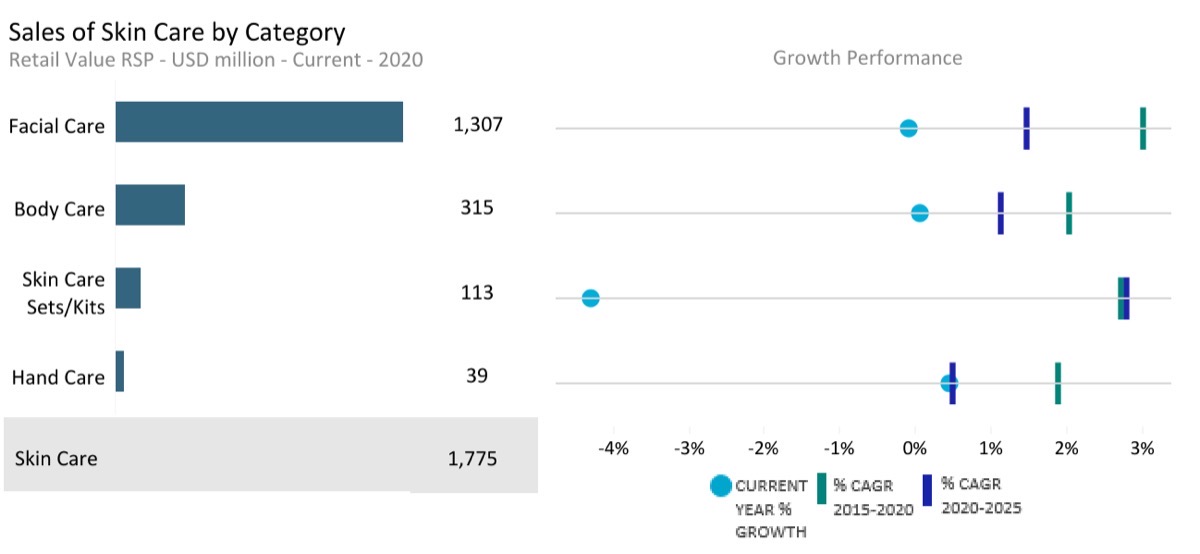
Note: Current year growth in the above chart refers to the period 2019-20
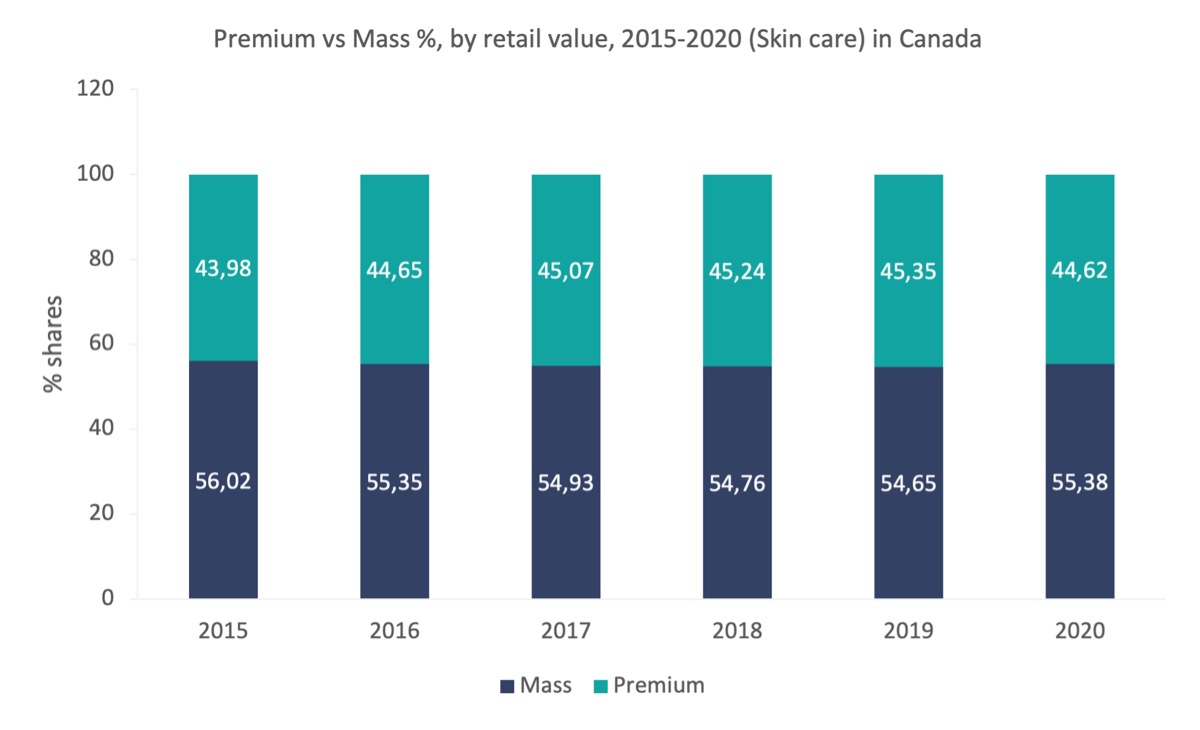
Category
Unit
Market size (2020)
Retail value RSP
Forecast compound annual growth rate (2020/2025) %
Skin Care
USD million
1,774.62
1.48
Body Care
USD million
314.58
1.14
Facial Care
USD million
1,307.48
1.48
Hand Care
USD million
39.31
0.49
Skin Care Sets/Kits
USD million
113.25
2.81
- Channel distribution
-
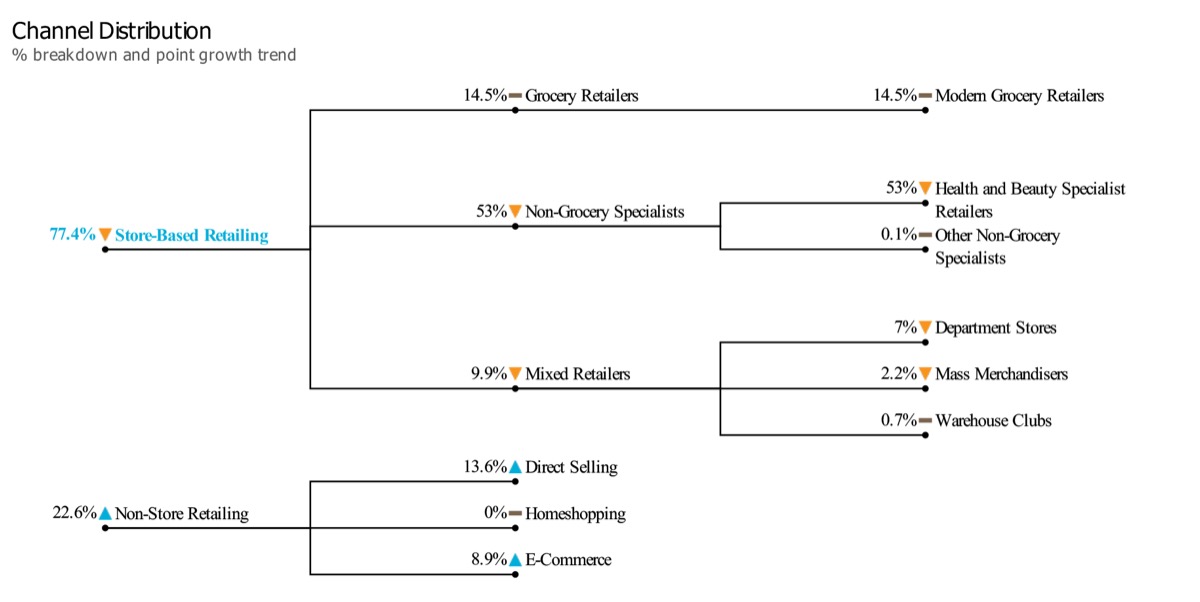
Note: The chart here showcases the retail value share of different channel sales for skin care products in Canada in 2020. The triangle/dash represents whether the specific channel share has increased/decreased or remained the same against its share in the previous year.
- Market Insights
-
Market trends
- Skin care saw a slight decline of 0.3% in retail value sales growth during 2020. The premium brands were the most affected as non-essential channels, which offer the bulk of premium products, were closed during lockdowns. Moreover, those premium names that were available elsewhere suffered from consumers trading down to mass brands or buying less frequently because of a loss in purchasing power. On the other hand, hand care, especially mass hand care, received a boost from consumers washing and sanitising their hands more frequently in 2020. Conversely, there has been less need for firming/anti-cellulite body care and acne treatments given the extended home seclusion and lack of socialising. Lip care was also negatively affected by home seclusion and people wearing PPE masks, which reduced the need for facial skin care.
- Canadian consumers focus on pampering and self-care tomaintain skin health as a preventative measure against stress. The pampering trend supported sales of general-purpose body care, which was also bolstered by consumers shifting to body care as an extension of skin care for the face.
- E-commerce sales of skin care increased strongly in 2020 as brands, retailers and Canadian shoppers embraced online shopping during the lockdowns and throughout the year. Brands such as Canadian beauty brand Marcelle provided information on its e-commerce site to assure the safety of online shopping, thanking customers for shopping with them and donating to frontline workers. Online sales were further boosted by an increasing product range and loyalty programmes such as Shoppers Drug Mart PC Optimum Program. The loyalty programme enables customers to accumulate points not only at Shoppers Drug Mart but at other Loblaw-owned retailers such as Loblaw grocery stores. The points can then easily be used to make purchases online.
Prospects and growth opportunity
- Skin care is expected to recover over the forecast period (2020-2025) as the economy recovers and consumers resume discretionary spending. Sales growth of premium skin care at 2020 prices is expected to outpace mass skin care in the medium term. However, the premium firming/anti-cellulite body care is predicted to continue its decline in sales in the short term. Premium products that typically feature high-quality formulations are likely to be favoured. However, mass players are likely to remain competitive through innovations that cater to ongoing skin care and natural beauty trends. For example, Shoppers Drug Mart’s private label Quo Beauty offers a vegan and cruelty-free Hydrating Facial Serum with Vitamin C and Sodium Hyaluronate.
- The growth of the e-commerce channel’s value share is expected to slow down as consumers return to brick-and-mortar shopping, but online shopping is likely to remain at increased sales levels compared to pre-pandemic levels. Many brands and retailers introduced tools to enhance the digital shopping experience for consumers. For example, premium beauty brand Lancôme’s e-commerce site has a chat widget to enable online shoppers to engage with Lancôme beauty experts, a virtual consultation tool, product reviews, free shipping over CAD50 and free samples with all orders.
General health & wellness trends
- Brands in Canada are increasingly focused on creating their offline presence by opening new stores. As a sign of the evolving retail environment, direct seller Avon launched Studio 1886 at the end of 2020, the first of three stores planned for Canada. The store is an immersive experience designed to allow Avon representatives to engage with customers to introduce products through trials and sampling. Furthermore, South Korean premium beauty brand the History of Whoo also opened its first Canadian store at the end of 2020 with plans for more stores, including store-in-store concepts at luxury department stores.
Dog & Cat Food
- Market size and growth
-
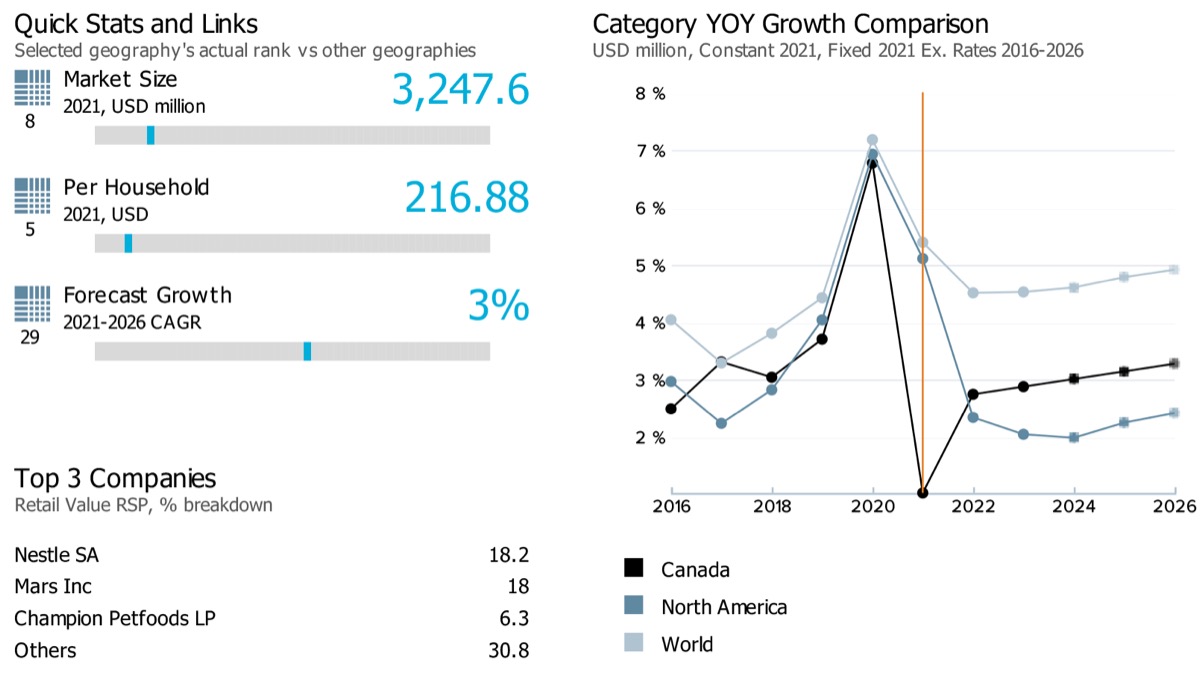
Note: Data on the top left corner of the image (8, 5 and 29) showcases respective ranks for Canada for its market size, per capita, and forecast growth rate compared against 53 countries globally. The blue line on the grey bar represents the relative position of the country as per their rank.
Note: Latest market size data for the year 2021 has been shared for Dog and Cat food
Performance of retail value sales of dog and cat food in Canada is estimated to slow down from a historic compound annual growth rate (CAGR) of 5.2% during 2016-2021 to an estimated forecast CAGR of 3.0% over 2021-2026. The category’s performance in the country has been slightly slower than its global performance. Globally, the category witnessed a historic CAGR of 6.9% and an estimated forecast CAGR of 4.7% during the same period.
- Sub-category breakdown
-
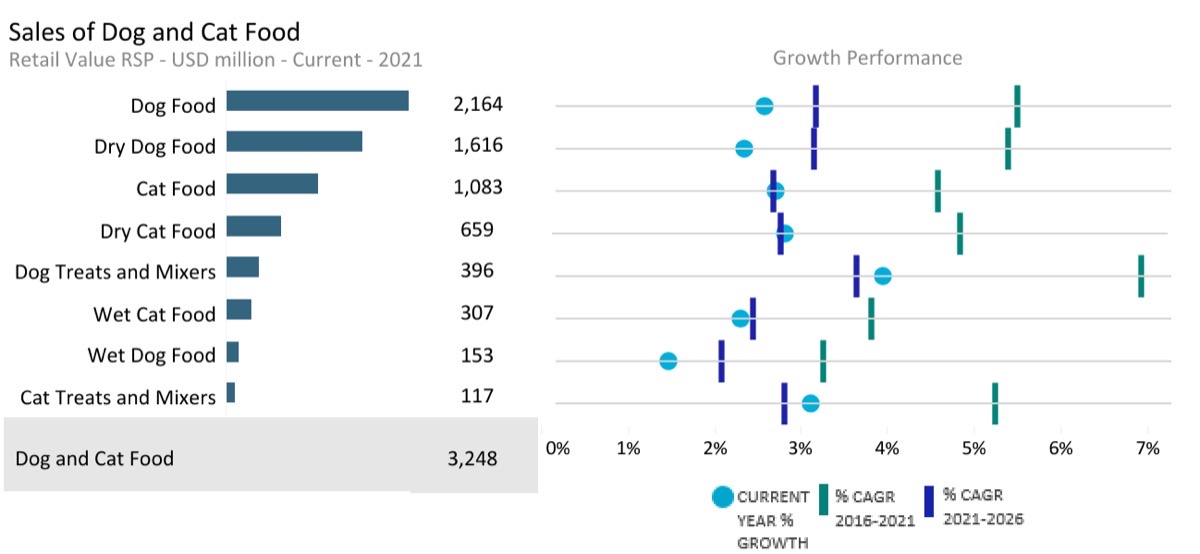
Note: Current year growth in the above chart refers to the period 2020-21
Category
Unit
Market size (2021)
Retail value RSP
Forecast compound annual growth rate (2021/2026) %
Dog and Cat Food
USD million
3,247.56
3.01
Dog Food
USD million
2,164.32
3.17
Dog Treats and Mixers
USD million
395.59
3.63
Dry Dog Food
USD million
1,616.03
3.15
Wet Dog Food
USD million
152.68
2.09
Cat Food
USD million
1,083.24
2.68
Wet Cat Food
USD million
307.02
2.44
Dry Cat Food
USD million
658.76
2.78
Cat treats and mixers
USD million
117.46
2.82
- Channel distribution
-
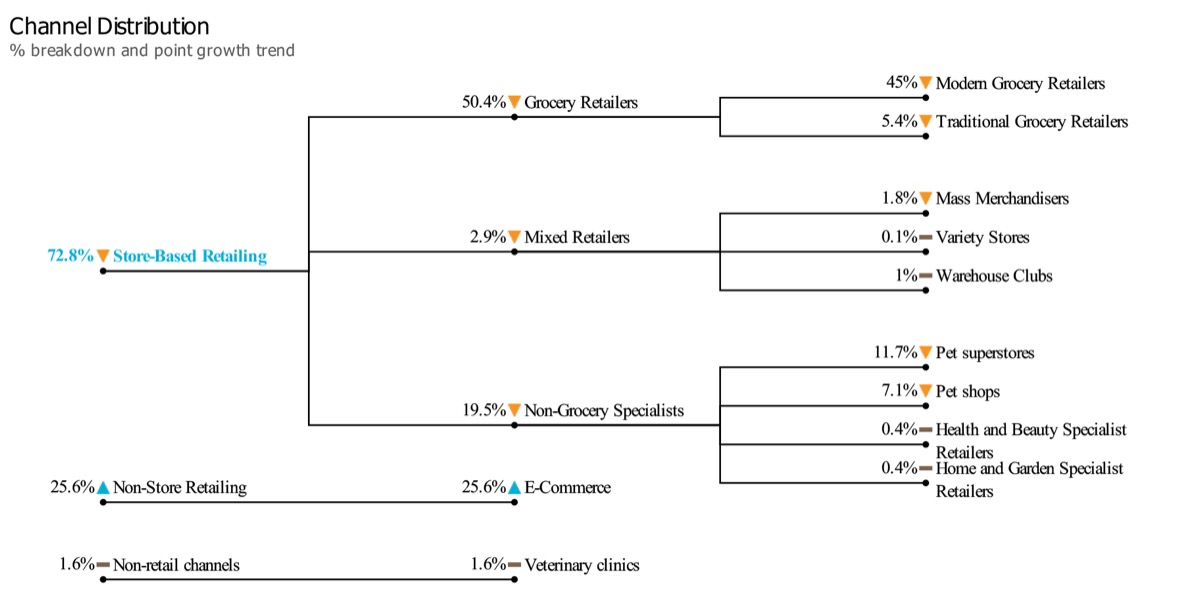
Note: The chart here showcases the retail value share of different channel sales for dog and cat food products in Canada in 2021. The triangle/dash represents whether the specific channel share has increased/decreased or remained the same against its share in the previous year.
- Market Insights
-
Market trends
- Dog food in Canada is expected to witness a slower current value growth of 2.6% at the end of 2021 as the artificially boosted growth of 8% in retail value sales seen in 2020 begins to stabilise. As the pandemic comes to an end and Canadians return to their pre-pandemic lives, the sudden boom in new dogs and puppies’ adoption is likely to slow down as pet-owners return to work and restrictions ease. The humanisation trend will continue to positively impact dog food in Canada in the current year. Likewise, the humanisation trend will also shape new product developments. For example, there will be more interest in food with a healthy positioning such as free-from and raw food. Key brand launches so far include Nature’s Recipe treats for dogs from Smucker Foods of Canada and Vital Essentials FUSION from Carnivore Meat Company. In terms of specific brands, Nestlé Purina PetCare Co and Mars Canada remained the leading players in dog food in value terms in 2020, with their well-known brands, a presence in both wet and dry dog food and widespread distribution through both mass and specialist retailers.
- Similarly, cat food is expected to witness a slower growth of 2.7% at the end of 2021 after registering a strong growth of 6.1% in 2020. Current value sales of cat food will slow in 2021 as the pandemic comes to an end and stabilisation occurs, and Canadian cat-owners return to their pre-pandemic routines. As cat owners increasingly treat their pet cats as family members and want the best for them, they are becoming more discerning in the cat food choices they make. Buzz words used on the packaging of human foods are now also seen on cat food, including organic, holistic, all-natural, no artificial flavours or colours, no additives, non-GMO, gluten-free and high protein. The competitive environment in Canada is very concentrated in cat food, with Nestlé Purina PetCare Co and Mars Canada accounting for a combined share of 45.7% in 2020. Whiskas (Mars) and Purina Friskies (Nestlé Purina) remained the leading brands and held significant value shares, which indicates a general preference amongst Canadian cat owners for good value offerings.
Prospects and growth opportunity
- Within pet food, new approaches to marketing and sales strategies will be seen over the forecast period (2016-2021). The main reason for this is that traditional sampling and in-store promotional activities will continue to be limited, at least in the first part of the forecast period, due to the COVID-19 pandemic. As a result, stronger investments will be witnessed in digital and online approaches, which is already seen in countries like China, where e-commerce is more advanced. Consequently, it is also likely that smaller and niche brands will benefit from this as merchandising and shelf space will not be as critical as seen over the review period.
- Similarly, e-commerce space and digital marketing initiatives are likely to gather pace in the forecasted period to 2026. E-commerce is expected to go through significant changes and become more user friendly, such as offering more pictures and product descriptions. Furthermore, key online pet specialist retailers such as Petsmart.ca will become increasingly important compared with bricks-and-mortar alternatives. Some retailers with both an online and a physical presence will continue offering considerable discounts to encourage online purchases. Moreover, modern online retailing options such as subscription-based dog food will also grow rapidly due to convenience and affordability.
General health & wellness trends
- After witnessing a drastic increase in 2020, the dog population will continue to slow down as the pandemic comes to an end and Canadians return to their pre pandemic lives. The sudden boom in new dogs and puppies will also slow, as pet-owners return to work and restrictions ease. However, the lifespan of dogs will increase over the forecast period, which will benefit the demand for dog food between 2022-2026. In terms of the economy, it is uncertain how long the recovery process will be. However, as pets are increasingly viewed as family members, pet food will continue to be an essential item, with dog owners wanting to pay extra for premium products, regardless of ongoing economic concerns.
- In addition, there will be more of a focus on ethically and sustainable dog food over the forecast period, as many new companies are focusing on lab-cultured meat protein. This is part of the broader sustainability trend that is being witnessed in Canada and across the globe. Likewise, the humanisation trend will also heavily impact new product developments over the forecast period (2021-2026) as healthier dog food is expected to become increasingly popular. One development that could be seen in the forecast period is vegan dog food, although there is currently little research on the nutritional suitability of vegan diets for dogs.
Alcoholic Drinks
- Market size and growth
-
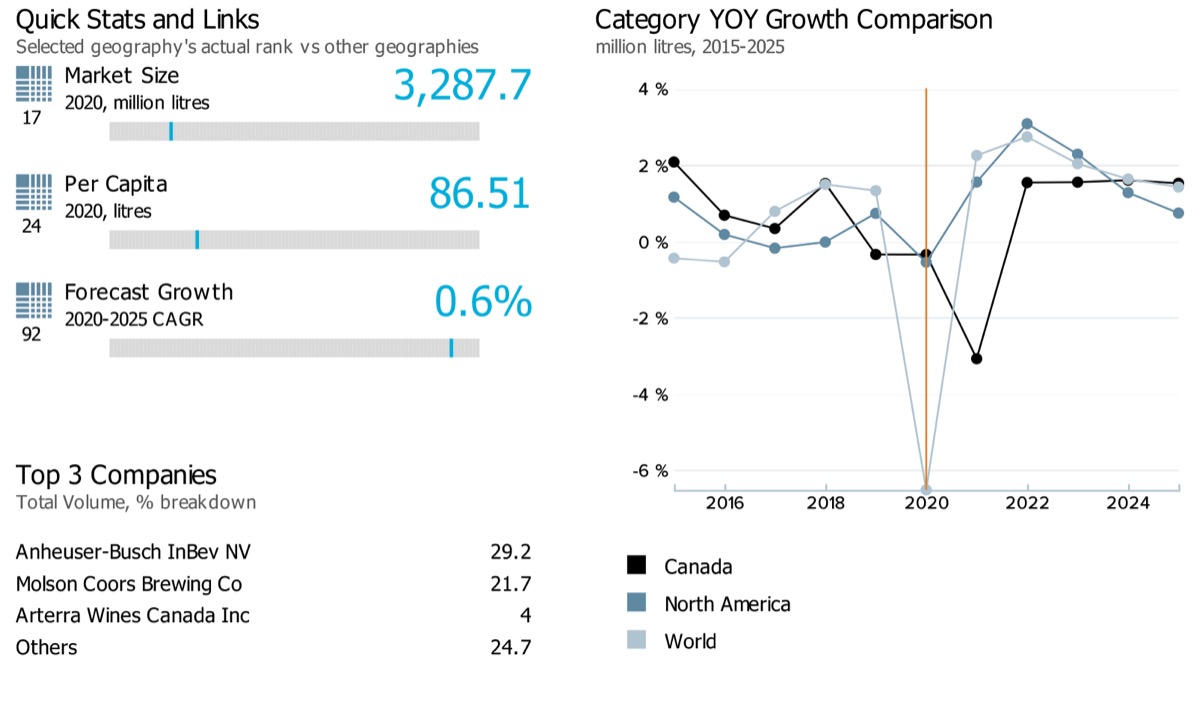
Note: Market size data for the alcoholic drinks category in the country reflects the total volume in a million litres. Data on the top left corner of the image (17, 24 and 92) showcases respective ranks for Canada for its market size, per capita, and forecast growth rate compared against 99 countries globally. The blue line on the grey bar represents the relative position of the country as per their rank.
The compound annual growth rate (CAGR) for alcoholic drinks Canada, both in terms of total value and volume, is expected to gain momentum over the forecast period (2020-2025: FCAGR for total value: 3.8% and for total volume: 0.6% ) against its performance in the historic period (2015-2020: HCAGR for total value: 1.1% and for total volume: 0.4% ). This is mainly in line with the category’s performance at the global level, where both in terms of total value and volume, alcoholic drinks are expected to gain momentum over the forecast period (2020-2025: FCAGR for total value: 4.6% and for total volume: 2.0% ) against its performance in the historic period (2015-2020: HCAGR for total value: 0.9% and for total volume: -0.7% )
- Sub-category breakdown
-
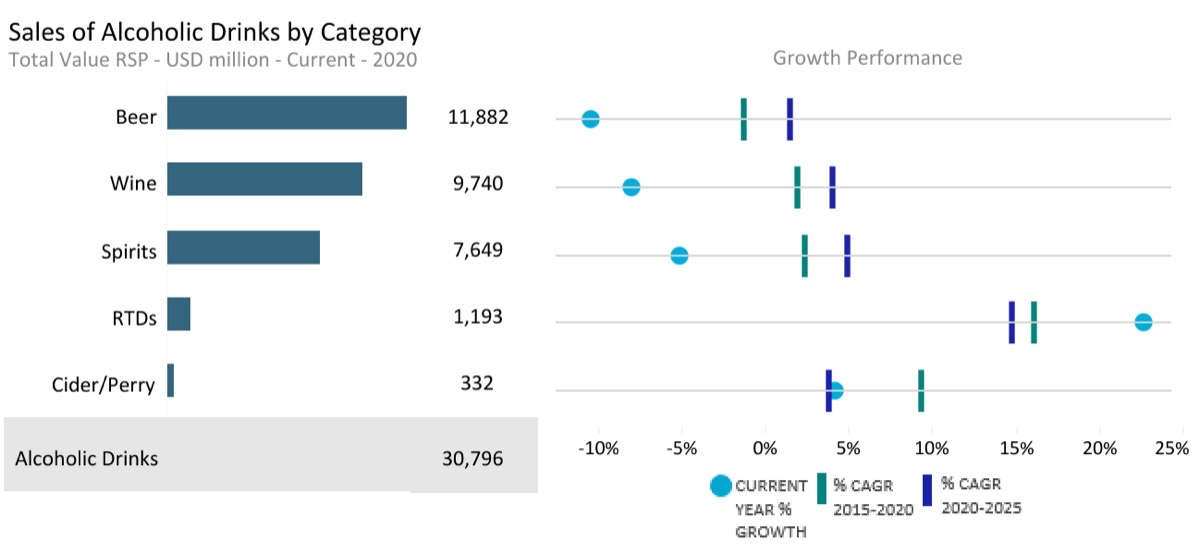
Current year growth in the above chart refers to the period 2019-20
Category
Data type
Market size (2020)
USD million
Forecast compound annual growth rate (2020/2025) %
Alcoholic Drinks
Total Value RSP
30,795.59
3.83
Alcoholic Drinks
Off-trade Value RSP
22,168.92
0.89
Alcoholic Drinks
On-trade Value RSP
8,626.66
10.14
Beer
Total Value RSP
11,881.80
1.51
Beer
Off-trade Value RSP
7,868.03
-2.22
Beer
On-trade Value RSP
4,013.77
7.55
Cider/Perry
Total Value RSP
331.87
3.79
Cider/Perry
Off-trade Value RSP
284.94
1.78
Cider/Perry
On-trade Value RSP
46.93
13.55
RTDs
Total Value RSP
1,193.05
14.71
RTDs
Off-trade Value RSP
977.29
14.43
RTDs
On-trade Value RSP
215.76
15.92
Spirits
Total Value RSP
7,648.59
4.88
Spirits
Off-trade Value RSP
5,099.41
0.65
Spirits
On-trade Value RSP
2,549.18
11.74
Wine
Total Value RSP
9,740.28
4.05
Wine
Off-trade Value RSP
7,939.25
1.74
Wine
On-trade Value RSP
1,801.03
12.36
- Channel distribution
-
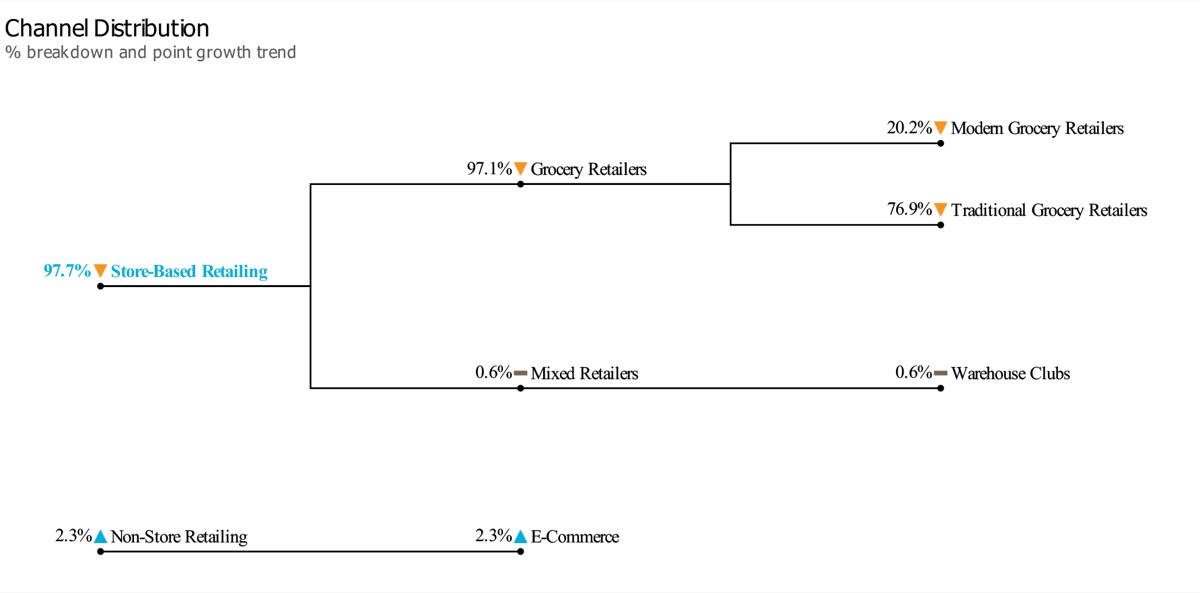
Note: The chart here showcases the off-trade volume share of different channel sales for alcoholic drink products in Canada in 2020. The triangle/dash represents whether the specific channel share has increased/decreased or remained the same against its share in the previous year.
- Market Insights
-
Market trends
- COVID-19 led to a decline for alcoholic drinks in Canada. The category witnessed a 0.4% decline in total volume growth in 2020 and is expected to decline even further by 3.1% in 2021. The main reason was attributed to the closure of on-trade venues leading to a double-digit decline in volume sales. In addition to this, rising price sensitivity due to COVID-19 also hampered visits to on-trade establishments, with many consumers reluctant to spend on drinks outside of the home. While the on-trade suffered a significant decline, all categories recorded off-trade volume growth in 2020 due to increased home consumption and the closure of on-trade venues. For example, RTDs saw the most significant off-trade growth, offsetting the decline seen in the on-trade to result in positive volume growth for the year. Many consumers were keen to spend as little time as possible in public, which boosted sales of e-commerce during 2020. The rising share in e-commerce was also supported by players launching or improving their e-commerce sites, with the Liquor Control Board of Ontario (LCBO), The Beer Store (TBS) and Société des Alcools du Québec (SAQ) offering online sales, while Uber Eats offered alcoholic drink deliveries.
- Beer registered a decline of 2.2% in total volume growth in 2020 and is expected to witness a further decline of 4.3% in 2021. This was mainly because of the fall in on-trade volume sales, which fell by 33% for the same reasons mentioned above. However, the off-trade volume sales gained momentum in 2020 as it recorded a growth of 6%, compared to a volume decline the previous year. In response to the outbreak of COVID-19, players emphasised their Corporate Social Responsibility (CSR) activities in their marketing during 2020, which led to less emphasis on traditional advertising. Labatt and other large brewers also made hand sanitiser, whilst some craft producers followed their lead. The heightened awareness of health and wellness among the people led to the launch of organic products, such as Coors Organic, a non-alcoholic beer launched in summer 2020, and higher sales of non-alcoholic products.
- On a very similar line, on-trade volume sales of spirits took a deep decline in 2020; however, off-trade volume growth saw a significant rise of 13%, leading to total volume growth of 6.2% for spirits, despite the outbreak of COVID-19. The pandemic also heightened health awareness, which impacted consumers' habits and purchasing behaviour during 2020. As such, non-alcoholic spirits recorded the highest levels of off-trade volume growth, with a 275% uplift recorded. Organic offerings such as Prairie Organic Vodka and non-alcoholic spirits became popular with consumers who did not previously purchase the products. Before the outbreak of COVID-19 in 2020, e-commerce was recording under 1% of the share on the landscape. However, this growth increased to 3% post-Covid. Due to increased price sensitivity in the country, many Canadians appreciated e-commerce as it allowed them to compare price points from various sites before making a purchasing decision.
Prospects and growth opportunity
- Several other non-COVID-19-related factors are expected to positively impact the performance of beer in the forecast period. For instance, the expansion of beer sales in Ontario and BC (British Columbia) is expected to continue. At the end of the review period, a growing number of outlets in Ontario received licences to sell alcohol, mostly beer, wine, and cider. Interprovincial sales are also likely to receive support, whilst grocery stores in BC are likely to see an increasing selection of international alcoholic beverages, contributing to growth in beer. However, a major challenge is that the consumer groups for cannabis users and beer drinkers can sometimes overlap. Players in beer are concerned that growing interest in cannabis could challenge beer for consumer dollars. Economy beers could be especially vulnerable, whilst premium and imported beers may be more resistant to this threat.
- Tequila (and mezcal) is expected to record strong total growth in the forecast period, with 2022 being the peak year for recovery. Thanks to a strong off-trade performance, single malt Scotch whisky is also likely to see one of the strongest performances. Meanwhile, rum is struggling to return to total volume growth, which was already a trend at the end of the review period and is expected to continue in the forecast period. Vodka is not likely to return to the level of volume sales seen in 2019. However, the on-trade is expected to see a better performance. Domestic vodka producers are expected to benefit from a ruling in 2019, allowing them to make vodka from agricultural ingredients other than potatoes, such as fruit, honey, and even dairy.
General industry trends
- Beer manufacturers will need to adapt to the new reality over the forecast period (2020-2025). This includes changing traditional marketing approaches, such as in-store activations, as consumers will not want to participate in sampling, especially in the early forecast period. Retail players will also adapt by diversifying their product offerings and increasing their presence on e-commerce and their overall social and digital strategies. For example, Molson’s Ship & Sip program offers deliveries directly to the consumer's doors. There is expected to be a rise in activities such as this across the forecast period to 2025. Major brewers will also be expanding to invest in non-beer across the coming years. For example, AB InBev’s have begun to expand its offerings, including the offering of Babe, a canned Rose with bubbles, bought to the country through its Canadian subsidiary Labatt Brewing.
Health & Wellness Packaged Food & Beverages
- Market size and growth
-
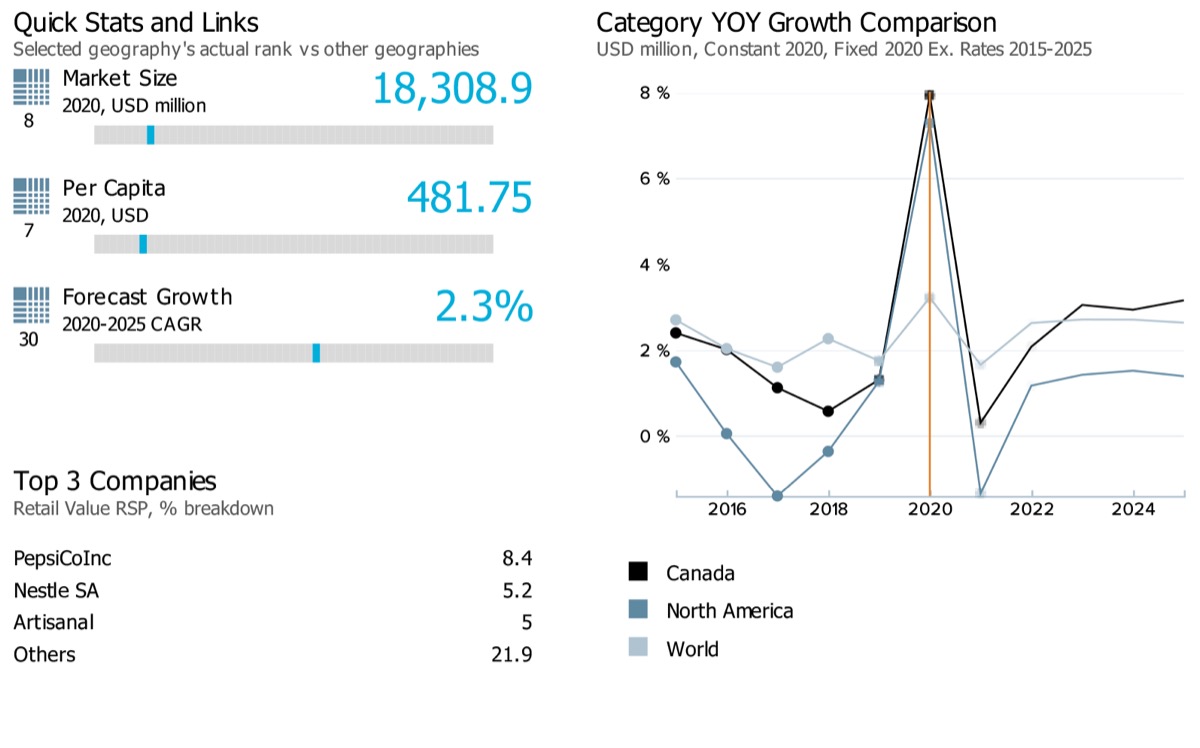
Note: Data on the top left corner of the image (8, 7 and 30) showcases respective ranks for Canada for its market size, per capita, and forecast growth rate compared against 53 countries globally. The blue line on the grey bar represents the relative position of the country as per their rank.
The retail value sales of health and wellness food and beverage products in Canada is expected to slow down when comparing the compound annual growth rates from historic to forecast periods, i.e. (4.3% during 2015-2020 to 2.3% during 2020-2025). This was also the case with the category’s performance at the global level, where its compound annual growth rate for retail value sales is estimated to slow down from 4.6% during 2015-2020 to 2.4% during 2020-2025.
- Sub-category breakdown
-
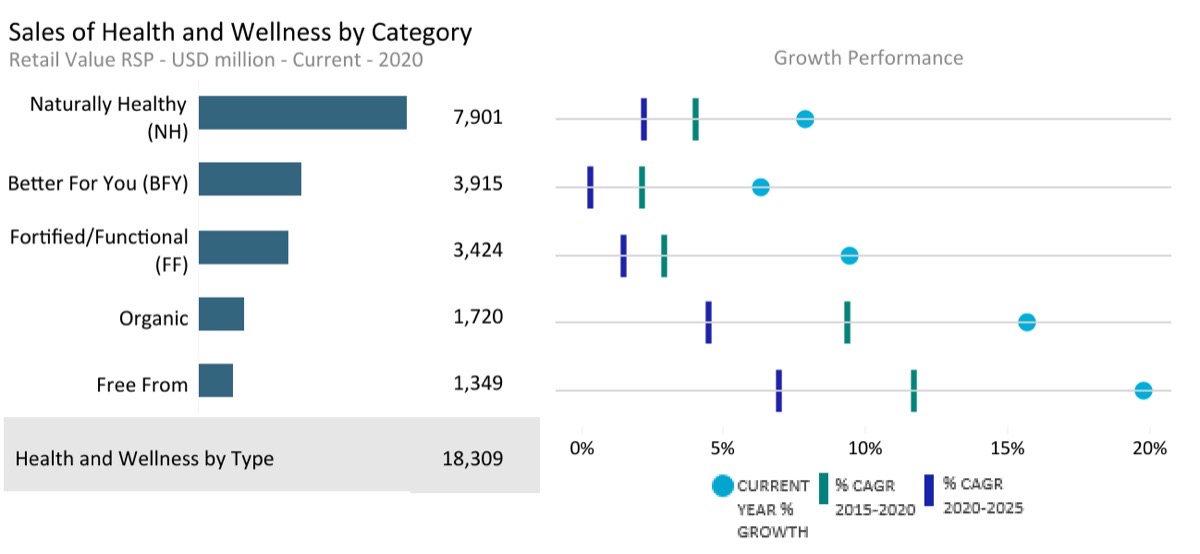
Current year growth in the above chart refers to the period 2019-20.
Category
Unit
Market size (2020)
Retail value RSP
Forecast compound annual growth rate (2020/2025) %
Health and Wellness by Type
USD million
18,308.86
2.28
Better For You (BFY)
USD million
3,915.08
0.31
Fortified/Functional (FF)
USD million
3,423.89
1.48
Free From
USD million
1,348.51
6.95
Naturally Healthy (NH)
USD million
7,900.92
2.19
Organic
USD million
1,720.45
4.47
- Channel distribution
-
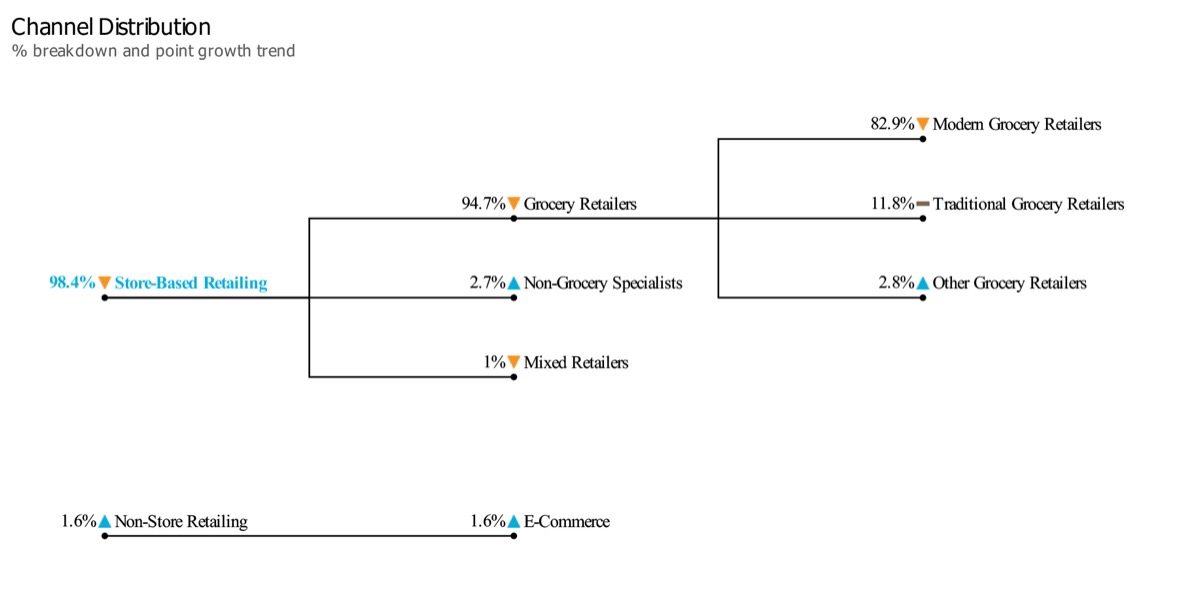
Note: The chart here showcases the retail value share of different channel sales for health and wellness by type products in Canada in 2020. The triangle/dash represents whether the specific channel share has increased/decreased or remained the same against its share in the previous year.
- Market Insights
-
Market trends
- COVID-19 had a significant impact on demand for a range of products, including health and wellness packaged food and beverages in Canada. Initially, there was a spike in demand for these products, especially those with a long shelf life, with consumers concerned about supply shortages. Although sales subsequently stabilised, demand remained above that seen during the review period (2015-2020) for most products. Immunity-boosting ingredients were a key driver of demand, as was reflected in increased demand for packaged food and beverages with ingredients such as vitamins C, D and E, iron, zinc, ginger and echinacea. Some stock shortages were seen as manufacturers struggled to keep up with demand, such as in reduced caffeine coffee and FF (fortified/functional) breakfast cereals, although these were largely short-lived. The disruption to foodservice positively impacted retail sales, with categories such as health and wellness coffee, dairy, breakfast cereals, ready meals, and bread benefiting from consumers spending more time at home.
- Fortified/functional (FF) beverages witnessed a current value growth of 8% and retail volume growth of 5% in 2020. The average unit price of FF beverages rose by 3% in 2020. FF sports drinks benefited from the lockdown, with many households stockpiling their favourite beverages, including the popular Gatorade and Powerade brands. Reduced sugar variants of both FF energy drinks and FF sports drinks witnessed stronger growth than the regular versions. The outbreak of COVID-19 not only influenced the way people shop but also caused them to reflect on their nutrition, focusing on the immune system. FF 100% juice was one of the key beneficiaries of this, with it already having a relatively healthy image among consumers. FF fruit/herbal tea also benefited from the increased demand for immunity-boosting products with several varieties linked to a healthy immune system. For example, leading player Flora Mfg. & Distributing Ltd witnessed dynamic growth in 2020 with its Flora Medicinal Tea brand.
- Naturally healthy (NH) beverages saw current value growth of 4% and retail volume growth of 3% in 2020. The average unit price of NH beverages rose by 2% in 2020. Driven by a desire to consume more immunity-boosting food and drink, consumers started buying more NH fruit/vegetable juice. This provided a significant boost to sales of products that promote their immunity-boosting properties, such as a high content of vitamins C. There was also increased demand for NH superfruit juice, with these products being perceived to be full of antioxidants. Some of the leading players within NH fruit/vegetable juice also looked to alter their marketing to reflect the current circumstances. For example, A Lassonde Inc’s Oasis brand focused on offering products to help consumers stay focused, relaxed and energised during this COVID-19 era.
Prospects and growth opportunity
- Fortified/functional beverages are expected to see healthy growth over the forecast period (2020-2025). They are projected to increase at a 7% current value compound annual growth rate (5% 2020 constant value CAGR) and a retail volume CAGR of 3%.A key driver of this is likely to remain products that claim to help support a healthy immune system. While many products are already fortified with immunity-boosting ingredients, more players will likely rename, repackage, and reposition their products, focusing on the immune system. This trend is also likely to be seen in fortified/functional tea, with a range of ingredients such as peppermint and chamomile, which have immunity-boosting claims. However, this focus on a healthy immune system could lead to fewer products on retailers’ shelves with other positionings, such as digestive and cardiovascular health.
- The outlook for naturally healthy beverages looks largely positive, with these products perceived to be healthier than many of the alternatives. The growing focus on clean labels and healthy ingredients puts naturally healthy beverages in a strong position. Nevertheless, one potential obstacle to growth is the proposed regulation changes discussed between the government and industry stakeholders. If they go ahead, they could lead to front-of-pack labelling that highlights products with a high sugar, fat, or salt content and restricts advertising of these products to children. This could potentially impact some products with naturally healthy fruit/vegetable juice which often carry high amounts of natural sugars. However, producers will likely argue that the health benefits of these products outweigh the negatives.
General health & wellness trends
- COVID-19 has caused consumers to pay closer attention to what they eat and drink and how it could impact their immune system, which is likely to inform new product development. Manufacturers have already introduced new products which explicitly promote their immunity-boosting claims, and more are likely to appear, especially within naturally healthy (NH) tea and NH fruit/vegetable juice. NH green tea and NH RTD tea should also benefit from this trend, with these products already well-known for their antioxidant properties.
- E-commerce witnessed dynamic growth within functional/fortified beverages in 2020, and it is likely to see further development over the forecast period. As such, manufacturers may be forced to change their strategies, including how they market their products. There is likely to be a stronger focus on social media, while the move online could also open the door to smaller and more specialised players targeting specific health claims or specific consumer groups. Manufacturers may also use online sales as an incubator to see how new and novel products perform, such as novel ingredients. The way consumers shop for products online is different, with the ability to research products and read reviews creating greater scope for consumers to try out new innovations.
Retail Landscape
- Brand shares of supermarkets
-
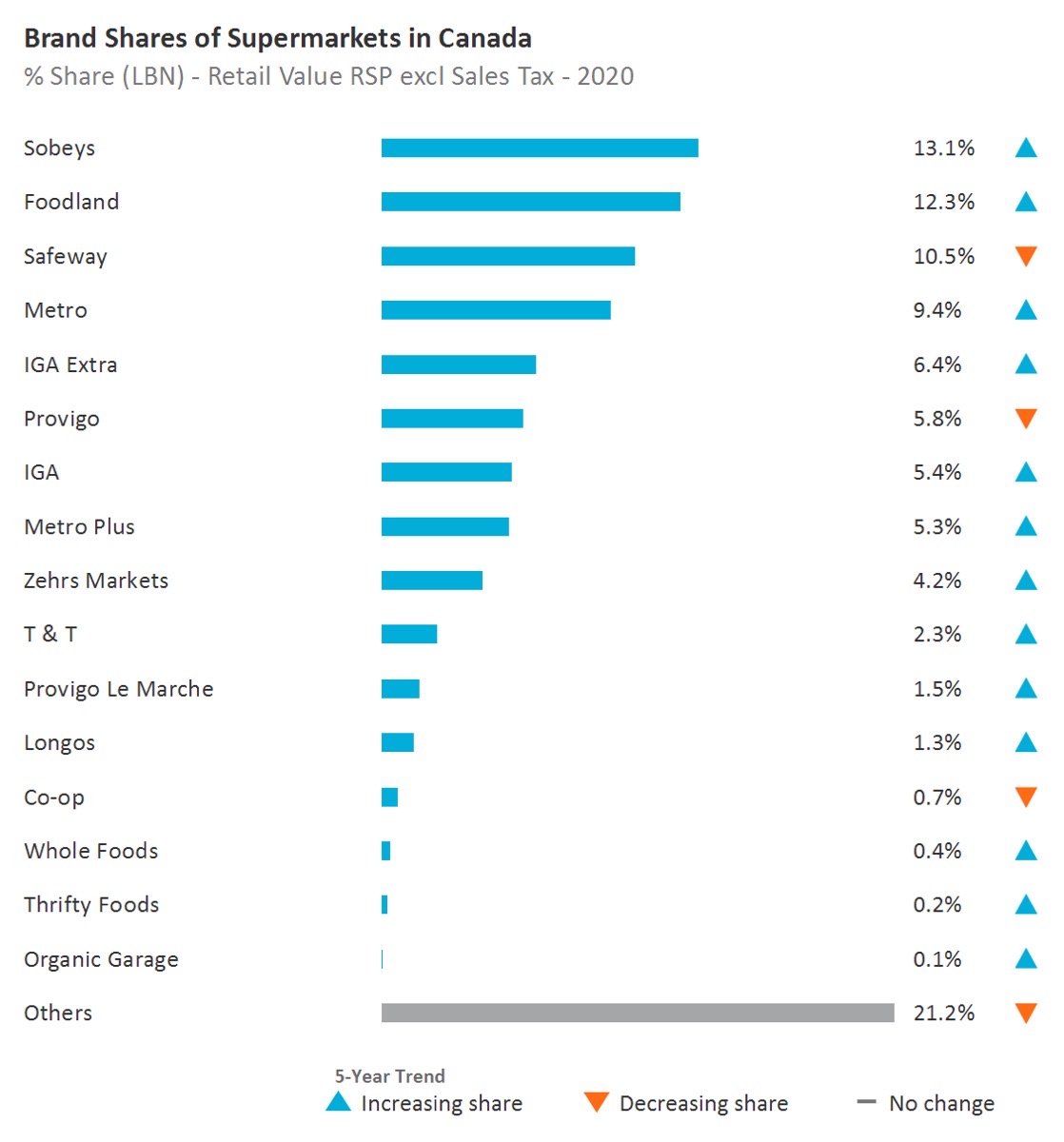
- Brand shares of chemists/pharmacies
-
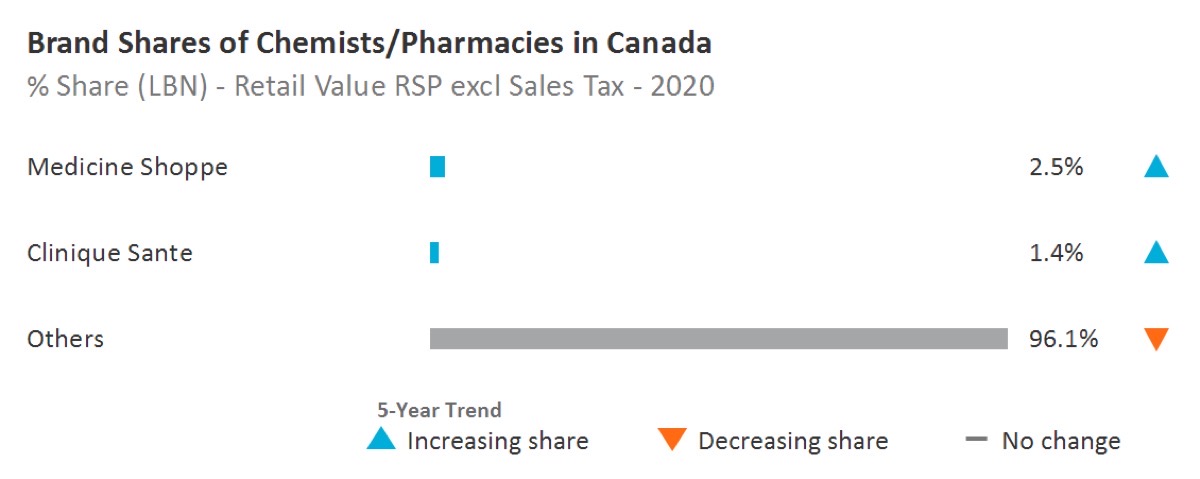
- Retail insights
-
- Most retailers in Canada suffered significantly due to the drop in foot traffic during COVID-19. The strong spike in e-commerce sales was not enough to offset the loss in stores during the lockdown, primarily in department stores, leisure and personal goods and even apparel and footwear specialist retailers. Many retailers also were impacted by lower demand from consumers that were more financially impacted by business closures and job losses. Grocery retailers and warehouse clubs delivered by far the strongest performance, as consumers stockpiled and spent more time at home. In general, grocery retailers that initiated, expanded, or otherwise improved their food delivery services – on their own or in partnership with Instacart, for example, and retailers like Walmart and Costco that sought to improve their fulfilment abilities were more successful during the year. All types of retailers tried with varying degrees of success to adapt to the loss in foot traffic by ramping up their e-commerce capacities to capitalise on the growing consumer demand.
- Over the review period (2015-2020), supermarkets responded to increasing consumer demand for convenience in the form of ready-to-eat meals and online delivery by introducing and/or strengthening these services. This strategy served supermarkets well in 2020, both in general and during the lockdown. Within the arena of ready-to-eat meals, Sobeys Inc continued to benefit from its recent introduction of Easy Meals, and other supermarkets that have adopted similar meal kit concepts also gained more traction while restaurants were closed. For example, Metro Inc’s value share surged in 2020, which is likely due to it acquiring a major stake in the online meal kit service MissFresh and started offering meal kits in its stores, enabling customers to buy individual boxes without committing to a weekly subscription.
- After the pandemic-led restrictions are lifted and online grocery sales growth levels have subsided, supermarkets are expected to continue to see a growing share of online grocery sales in 2021 and beyond. This can be expected as more consumers will be open to home delivery and in-store pickup as convenient ways of grocery shopping. Overall, the supermarket channel may still witness limited growth in the face of ever-stronger competition from the discounters channel and online players delivering fresh food (e.g. Uber Eats).
- The country's chemist/pharmacies market was valued at USD 4061.1 million in 2020 (Retail value RSP without sales tax). In 2020-2021, the channel's year-over-year growth rate was -2.1%. The value compound annual growth rate was 3.8% over the last five years (2015-2020). However, over the forecast period to 2025, the channel's retail value compound annual growth rate is expected to come down to 1.4%.
- Definitions
- Acronyms Used & Key Notes
Definitions
|
Industry |
Category |
Definition |
|---|---|---|
|
Alcoholic Drinks |
Alcoholic Drinks |
Alcoholic drinks are the aggregation of beer, wine, spirits, cider/perry and RTDs. |
|
Alcoholic Drinks |
Beer |
An alcoholic drink usually brewed from malt, sugar, hops and water and fermented with yeast. Some beers are made by fermenting a cereal, especially barley, and therefore not flavoured by hops. Alcohol content for beer is varied – anything up to and over 14% ABV (alcohol by volume), although 3.5% to 5% is most common. Beer is the aggregation of lager, dark beer, stout and non/low alcohol beer. |
|
Alcoholic Drinks |
Cider/Perry |
Cider is made from fermented apple juice while perry is made from fermented pear juice. Both artisanal and industrial cider/perry are included. |
|
Alcoholic Drinks |
RTDs |
RTD stands for ‘ready-to-drink’. Other terms which may be used for these products are FABs, alcopops and premixes. The RTDs sector is the aggregation of malt-, wine-, spirit- and other types of premixed drinks. These drinks usually have an alcohol content of around 5% but this can reach as high as 10% ABV. Premixes containing a high percentage of alcohol of around 15%+ combined with juice or any other soft drink are included here. RTDs are usually marketed as products to be drunk neat, with ice, or as a cocktail ingredient. Fruit-flavoured, vodka-based spirits with an alcohol content of between 16-21% are classified here. Examples: Alizé, Ursus Roter, Berentzen Fruchtige, Kleiner Feigling. |
|
Alcoholic Drinks |
Spirits |
This is the aggregation of whisk(e)y, brandy and Cognac, white spirits, rum, tequila, liqueurs and other spirits. |
|
Alcoholic Drinks |
Wine |
This is the aggregation of still and sparkling light grape wines, fortified wine and vermouth and non-grape wine. In terms of alcohol content, light wine usually falls into the 8-14% ABV bracket while fortified wine ranges from 14-23% ABV. Low and non-alcoholic wine is also included in the data (attributed to each sector as appropriate). |
|
Beauty and Personal Care |
Skin Care |
This is the aggregation of facial care, body care, hand care and skin care sets/kits. |
|
Beauty and Personal Care |
Body Care |
This is the aggregation of firming/anti-cellulite products and general-purpose body care. |
|
Beauty and Personal Care |
Facial Care |
This is the aggregation of acne treatments, moisturisers and treatments, facial cleansers, toners, face masks, and lip care. Please note that Moisturisers and Treatments is the aggregation of basic moisturisers and anti-agers. |
|
Beauty and Personal Care |
Hand Care |
Includes all hand moisturisers, both premium and mass market, as well as combination hand and nail products. Includes protective emollients and deep moisturisers formulated to sooth and hydrate very dry or irritated skin, as well as those that prevent, or that are suitable for, eczema-prone or redness-prone skin. Excludes medicated emollients and/or those positioned as treatment for eczema or psoriasis. |
|
Beauty and Personal Care |
Skin Care Sets/Kits |
Multiple skin care items of the same brand line packaged together in a set and priced at an advantageous price compared to purchasing the items separately. Includes traditional gift sets, multi-step skin care regimens, skin care starter kits (including acne treatment regimen sets/kits) and skin care travel kits (sold through retail outlets). Also includes sets, which comprise of products from multiple categories (e.g. makeup and skin care), as long as the primary product is skin care. Men’s, women’s and unisex versions are included. Excludes: GWP (Gift with Purchase) – consumer does not pay for this (e.g. free product when you purchase a set or a free sample kit). |
|
Consumer Health |
Dietary Supplements |
It is the aggregation of all dietary supplements: Minerals, fish oils/omega fatty acids, garlic, ginseng, ginkgo biloba, evening primrose oil, Echinacea, St John's Wort, protein supplements, probiotic supplements, eye health supplements, co-enzyme Q10, glucosamine, combination herbal/traditional supplements, non-herbal/traditional supplements, and all other dietary supplements specific to country coverage. |
|
Consumer Health |
Paediatric Vitamins and Dietary Supplements |
All vitamin and dietary supplement products formulated, designed, marketed and labelled specifically for children. |
|
Consumer Health |
Tonics |
Include versions of combination dietary supplements that are sold in the format of liquid concentrates, mini-drinks, shots or oral gels. Include concentrated energy shot boosters and tonics such as 5-Hour Energy and Lipovitan. Exclude remedies made with active pharmaceutical ingredients as well as super fruit juice concentrates and weight-loss beverages, tracked under the Health and Wellness (HW) system. |
|
Consumer Health |
Vitamins |
This is the aggregation of multivitamins and single vitamins. |
|
Health and Wellness |
Health and Wellness by Type |
Health and Wellness by Type is the aggregation of all health and wellness food and beverages broken down by organic, fortified/functional, naturally healthy, better for you and free from products. |
|
Health and Wellness |
Better For You (BFY) |
Products where the amount of a substance considered to be less healthy (eg fat, sugar, salt, carbohydrates) has been actively reduced during production. To qualify for inclusion in this category, the “less healthy” element of the foodstuff needs to have been actively removed or substituted during the processing. This should also form a key part of the positioning/marketing of the product. Products which are naturally fat/sugar/carbohydrate -free are not included as nothing out of the ordinary has been done during their production to make them “better for you”. “No added sugar” claims are excluded too. Products most likely to be included here will be those which are low-fat/low-sugar versions of standard products (i.e. reduced fat mayonnaise, reduced fat cheese, reduced fat milk, reduced sugar confectionery, etc). |
|
Health and Wellness |
Fortified/Functional (FF) |
This category includes fortified/functional food and beverages. When identifying fortified/functional products, we focus on products to which health ingredients or/and nutrients have been added as well as brands that are positioned to deliver a certain functionality. To be included here the enhancement must be highlighted in the label or hold a health claim/nutritional claim. Fortified/functional food and beverages provide health benefits beyond their nutritional value and/or the level of added ingredients wouldn’t normally be found in that product. To merit inclusion in this category, the defining criterion here is that the product must have been actively fortified/enhanced during production. As such, inherently healthy products such as 100% fruit/vegetable juices are only included under "fortified/functional" if additional health ingredients (e.g. calcium, omega 3) have been added. To be included, the health benefit needs to form part of positioning/marketing of the product. For product category definitions please refer to the definitions section (can be found under the "Help" section on Passport) for the respective system: Packaged Food, Hot Drinks, Soft Drinks. |
|
Health and Wellness |
Free From |
This category includes free from gluten, free from lactose, free from allergens, free from dairy and free from meat products. This excludes foods which are certified ‘free’ of a specific product when this is based on use of sterilised equipment. |
|
Health and Wellness |
Naturally Healthy (NH) |
This category includes food and beverages based on naturally containing a substance that improves health and wellbeing beyond the product’s pure calorific value. These products are usually a healthier alternative within a certain sector/subsector. High fibre food (wholegrain/wholemeal/brown), soy products, sour milk drinks, nuts, seeds and trail mixes, honey, fruit and nut bars and olive oil are considered NH foods and 100% fruit/vegetable juice, superfruit juice, natural mineral water, spring water, RTD green tea etc. are considered NH beverages. While many of these products are marketed on a health basis, this might not always be the case. Naturally healthy food and beverages that are additionally fortified fall into the 'fortified/functional' category. |
|
Health and Wellness |
Organic |
Certified organic products are those which have been produced, stored, processed, handled and marketed in accordance with precise technical specifications (standards) and certified as "organic" by a certification body such as the Soil Association in the UK, the European Union or the US Department of Agriculture. It is important to note that an organic label applies to the production process, ensuring that the product has been produced and processed in an ecologically sound manner. The organic label is therefore a production process claim as opposed to a product quality claim. Note: For organic products to be included, the organic aspect needs to form a significant part of the overall positioning/marketing of the product, including the organic certification label in the packaging. |
|
Pet Care |
Dog and Cat Food |
This is the aggregation of dog and cat food. |
|
Pet Care |
Cat Food |
This is the aggregation of wet and dry cat food. |
|
Pet Care |
Cat Treats and Mixers |
This is the aggregation of mixers and treats for cats. |
|
Pet Care |
Dry Cat Food |
These products have a moisture content of 10-14% and are generally packed into paper, plastic or cardboard. Dry cat food is typically made from a combination of grain-based ingredients (corn and rice) and a meat component. It is typically produced by extrusion cooking under high heat and pressure and then sprayed with fat to increase palatability. Other ingredients may also be added to complete its composition. This is the aggregation of premium, mid-priced and economy dry cat food. Note: semi-moist food is included here. These products are extruded (combining meat and cereal), have a higher moisture content (20-40%) and are usually packaged in plastic or foil sachets. |
|
Pet Care |
Wet Cat Food |
These products have a moisture content of 60-85% and are generally (though not always) preserved by heat treatment. They are packaged in steel or aluminium cans, rigid or flexible plastic or semi-rigid aluminium trays. This is the aggregation of premium, mid-priced and economy wet cat food. |
|
Pet Care |
Dog Food |
This is the aggregation of wet and dry dog food. |
|
Pet Care |
Dog Treats and Mixers |
This is the aggregation of mixers and treats for dogs. |
|
Pet Care |
Dry Dog Food |
These products generally have a moisture content of 6-14% and are generally packed into paper, plastic or cardboard. Complete dry dog foods fall into two broad categories: Flaked (or 'Muesli' type blended products) and Extruded products (meat and cereals cooked by direct steaming). This is the aggregation of premium, mid-priced and economy dry dog food. Note: semi-moist food is included here. These products are extruded (combining meat and cereal) have a higher moisture content (20-40%) and are usually packaged in plastic or foil sachets. |
|
Pet Care |
Wet Dog Food |
These products have a moisture content of 60-85% and are generally (though not always) preserved by heat treatment. They are packaged in steel or aluminium cans, rigid or flexible plastic or semi-rigid aluminium trays. This is the aggregation of premium, mid-priced and economy wet dog food. |
|
Retail in Alcoholic Drinks |
Store-Based Retailing |
Store-based retailing is the aggregation of grocery retailers and non-grocery specialists and mixed retailers. |
|
Retail in Alcoholic Drinks |
Grocery Retailers |
Retailers selling predominantly food/beverages/tobacco and other everyday groceries. This is the aggregation of hypermarkets, supermarkets, discounters, convenience stores, independent small grocers, forecourt retailers, food/drink/tobacco specialists and other grocery retailers. |
|
Retail in Alcoholic Drinks |
Convenience Stores |
Chained grocery retail outlets selling a wide range of groceries and fitting several of the following characteristics: Extended opening hours •Selling area of less than 400 sq. metres •Located in residential neighbourhoods •Handling two or more of the following product categories: audio-visual goods (for sale or rent), foodservice (prepared take-away, made-to-order, and hot foods), newspapers or magazines, cut flowers or pot plants, greetings cards, automotive accessories. Example brands include 7-Eleven, Spar. |
|
Retail in Alcoholic Drinks |
Discounters |
Discounters are retail outlets typically with a selling space of between 400 and 2,500 square metres. Retailers' primary focus is on selling private label products within a limited range of food/beverages/tobacco and other groceries at budget prices. Discounters may also sell a selection of non-groceries, frequently as short-term special offers. Discounters can be classified as hard discounters and soft discounters. Hard discounter: first introduced by Aldi in Germany, and also known as limited-line discounters. Retail outlets, typically of 300-900 square metres, stocking fewer than 1,000 product lines, largely in packaged groceries. Goods are mainly private-label or budget brands. Soft discounter: usually slightly larger than hard discounters, and also known as extended-range discounters. Retail outlets typically stocking 1,000-4,000 product lines. As well as private-label and budget brands, stores commonly carry leading brands at discounted prices. Discounters excludes mass merchandisers and warehouse clubs. Example brands include Aldi, Lidl, Plus, Penny, Netto. |
|
Retail in Alcoholic Drinks |
Forecourt Retailers |
Grocery retail outlets selling a wide range of groceries from a gas station forecourt and fitting several of the following characteristics: • Extended opening hours • Selling area of less than 400 sq. metres • Handling two or more of the following product categories: audio-visual goods (for sale or rent), take-away food (readymade sandwiches, rolls or hot food), newspapers or magazines, cut flowers or pot plants, greetings cards, automotive accessories. Example brands include BP Connect, Shell Select. Forecourt retailers includes both chained forecourt retailers and independent forecourt retailers. |
|
Retail in Alcoholic Drinks |
Hypermarkets |
Hypermarkets are retail outlets with a selling space of over 2,500 square metres and with a primary focus on selling food/beverages/tobacco and other groceries. Hypermarkets also sell a range of non-grocery merchandise. Hypermarkets are frequently located on out-of-town sites or as the anchor store in a shopping centre. Example brands include Carrefour, Tesco Extra, Géant, E Leclerc, Intermarché, Auchan. Excludes cash and carry, warehouse clubs and mass merchandisers. |
|
Retail in Alcoholic Drinks |
Supermarkets |
Retail outlets selling groceries with a selling space of between 400 and 2,500 square metres. Excludes discounters, convenience stores and independent grocery stores. Example brands include Champion, Tesco, Casino. |
|
Retail in Alcoholic Drinks |
Food/drink/tobacco specialists |
Retail outlets specialising in the sale of mainly one category of food, drinks store and tobacconists. Includes bakers (bread and flour confectionery), butchers (meat and meat products), fishmongers (fish and seafood), greengrocers (fruit and vegetables), drinks stores (alcoholic and non-alcoholic drinks), tobacconists (tobacco products and smokers’ accessories), cheesemongers, chocolatiers and other single food categories. Alcoholic drinks stores are retail outlets with a primary focus on selling beer/wine/spirits/other alcoholic beverages. Example brands include: Threshers, Gall & Gall, Liquorland, Watson’s Wine Cellar |
|
Retail in Alcoholic Drinks |
Independent Small Grocers |
Retail outlets selling a wide range of predominantly grocery products. These outlets are usually not chained and if chained will have fewer than 10 retail outlets. Mainly family owned, often referred to as Mom and Pop stores. |
|
Retail in Alcoholic Drinks |
Other Grocery Retailers |
Other retailers selling predominantly food, beverages and tobacco or a combination of these. Includes kiosks, markets selling predominantly groceries. Includes CTNs and health food stores, Food & drink souvenir stores and regional speciality stores. Direct home delivery, eg of milk, meat from farm/dairy is excluded. Sari-Sari stores in Philippines and Warung (Waroon) in Indonesia, that can either be markets or kiosks, are included in Other grocery retailers unless they occupy a separate permanent outlet building, in which case they are included in Independent small grocers. Outlets located within wet markets, particularly in South East Asia (often located in government-owned multi-story buildings) should be counted as separate outlets. Wine sales from Vineyards are included here. |
|
Retail in Alcoholic Drinks |
Non-Grocery Specialists |
Retail outlets selling predominantly non-grocery consumer goods. Non-grocery retailers is the aggregation of: • Apparel and footwear specialist retailers • Electronics and appliance specialist retailers • Health & beauty specialist retailers • Home and garden specialist retailers • Leisure and personal goods specialist retailers • Other non-grocery retailers |
|
Retail in Alcoholic Drinks |
Drugstores/parapharmacies |
Retail outlets selling mainly OTC healthcare, cosmetics and toiletries, disposable paper products, household care products and other general merchandise. Such outlets may also offer prescription-bound medicines under the supervision of a pharmacist. Drugstores in Spain (Droguerias) also sell household cleaning agents, paint, DIY products and sometimes pet products and services such as photo processing. Example brands include Rossmann (Germany), Kruidvat (Netherlands), Walgreen’s (US), CVS (US), Medicine Shoppe (US), Matsumoto Kiyoshi (Japan), HAC Kimisawa (Japan). |
|
Retail in Alcoholic Drinks |
Mixed Retailers |
This is the aggregation of department stores, variety stores, mass merchandisers and warehouse clubs. |
|
Retail in Alcoholic Drinks |
Department Stores |
Outlets selling mainly non-grocery merchandise and at least five lines in different departments, usually with a sales area of over 2,500 sq metres. They are usually arranged over several floors. Example brands include Macy’s, Bloomingdale’s, Marks & Spencer, Harrods, Sears, JC Penney, Takashimaya, Mitsukoshi, Daimaru, Karstadt, Rinascente. |
|
Retail in Alcoholic Drinks |
Mass Merchandisers |
Mixed retail outlets that usually: (1) convey the image of a high-volume, fast-turnover outlet selling a variety of merchandise for less than conventional prices; (2) provide centralised check-out service; and (3) provide minimal customer assistance within each department. Example brands include Wal-Mart, Target and Kmart. Excludes hypermarkets and warehouse clubs/cash and carry stores. |
|
Retail in Alcoholic Drinks |
Variety Stores |
Non-grocery general merchandise outlets usually located on one floor, offering a wide assortment of extensively discounted fast-moving consumer goods on a self-service basis. Normally over 1,500 sq. metres in size, except in the case of dollar stores, these outlets give priority to fast-moving non-grocery items that have long shelf-lives. Includes catalogue showrooms and dollar stores. Example brands include Woolworth (Germany), Upim (Italy). |
|
Retail in Alcoholic Drinks |
Warehouse Clubs |
Warehouse Clubs are chained outlets that sell a wide variety of merchandise but do have a strong mix of both grocery and non-grocery products. Customers have to pay an annual membership fee in order to shop. The clubs are able to keep prices low due to the no-frills format of the stores and attempt to drive volume sales through aggressive pricing techniques. Warehouse Clubs typically: - exceed 2,500 sq. metres of selling space and are invariably -over 4,000 sq. metres in size; - convey the image of a high-volume, fast-turnover retailing at less than conventional prices; - provide minimal customer assistance within each department; and - are situated in out-of-town locations. Example brands include: - Costco - Sam’s Club (Wal-Mart) - PriceSmart - Cost-U-Less |
|
Retail in Alcoholic Drinks |
Non-Store Retailing |
The retail sale of new and used goods to the general public for personal or household consumption from locations other than retail outlets or market stalls. Non-store retailing is the aggregation of Vending, Direct Selling, Homeshopping and Internet Retailing. |
|
Retail in Alcoholic Drinks |
Direct Selling |
Direct selling is the marketing of consumer goods directly to consumers, generally in their homes or the homes of others, at their workplace and other places away from permanent retail locations. Direct selling occurs in two primary ways: one-to-one basis (usually by prior arrangement a demonstration is given by a direct seller to a customer) or party-plan basis (selling through explanation and demonstration of products to a group of prospective customers by a direct seller usually in the home of a host(ess) who invites other persons for this purpose). |
|
Retail in Alcoholic Drinks |
Homeshopping |
Homeshopping is the sale of consumer goods to the general public via mail order catalogues, TV shopping and direct mail. Consumers purchase goods in direct response to an advertisement or promotion through a mail item, printed catalogue, TV shopping programme, or Internet catalogue whereby the order is placed, and payment is made by phone, by post or through other media such as digital TV. Excludes sales on returned products/unpaid invoices. Excludes sales ordered and paid online which are instead included within Internet retailing. |
|
Retail in Alcoholic Drinks |
E-Commerce |
Sales of consumer goods to the general public via the Internet. Please note that this includes sales through mobile phones and tablets. Internet retailing includes sales generated through pure e-commerce web sites and through sites operated by store-based retailers. Sales data is attributed to the country where the consumer is based, rather than where the retailer is based. Also includes orders placed through the web for which payment is then made through a storecard, an online credit account subsequent to delivery or on delivery of the product. This payment may be by any mode of payment including postal cheque, direct debit, standing order or other banking tools. Includes orders paid for cash on delivery. Includes m-commerce: where consumers use smart phones or tablets to connect to Internet and purchase the goods online. |
|
Retail in Alcoholic Drinks |
Vending |
Vending means automatic retailing. It covers the sale of products and services at an unattended point of sale through a machine operated by introducing coins, bank notes, payment cards, tokens or other means of cashless payment. Coverage includes vending systems installed in public and semi-captive environments only. Hotels, transport networks, recreational centres, shopping centres/malls are included. Factories, offices, hospitals, prisons, schools and other captive environments are excluded. |
|
Retail in Beauty and Personal Care |
Store-Based Retailing |
Store-based retailing is the aggregation of grocery retailers and non-grocery specialists and mixed retailers. |
|
Retail in Beauty and Personal Care |
Grocery Retailers |
Retailers selling predominantly food/beverages/tobacco and other everyday groceries. This is the aggregation of hypermarkets, supermarkets, discounters, convenience stores, independent small grocers, forecourt retailers, food/drink/tobacco specialists and other grocery retailers. |
|
Retail in Beauty and Personal Care |
Modern Grocery Retailers |
Modern grocery retailing is the aggregation of those grocery channels that have emerged alongside the growth of chained retail: Hypermarkets, Supermarkets, Discounters, Forecourt Retailers and Convenience Stores. |
|
Retail in Beauty and Personal Care |
Convenience Stores |
Chained grocery retail outlets selling a wide range of groceries and fitting several of the following characteristics: Extended opening hours •Selling area of less than 400 sq. metres •Located in residential neighbourhoods •Handling two or more of the following product categories: audio-visual goods (for sale or rent), foodservice (prepared take-away, made-to-order, and hot foods), newspapers or magazines, cut flowers or pot plants, greetings cards, automotive accessories. Example brands include 7-Eleven, Spar. |
|
Retail in Beauty and Personal Care |
Discounters |
Discounters are retail outlets typically with a selling space of between 400 and 2,500 square metres. Retailers' primary focus is on selling private label products within a limited range of food/beverages/tobacco and other groceries at budget prices. Discounters may also sell a selection of non-groceries, frequently as short-term special offers. Discounters can be classified as hard discounters and soft discounters. Hard discounter: first introduced by Aldi in Germany, and also known as limited-line discounters. Retail outlets, typically of 300-900 square metres, stocking fewer than 1,000 product lines, largely in packaged groceries. Goods are mainly private-label or budget brands. Soft discounter: usually slightly larger than hard discounters, and also known as extended-range discounters. Retail outlets typically stocking 1,000-4,000 product lines. As well as private-label and budget brands, stores commonly carry leading brands at discounted prices. Discounters excludes mass merchandisers and warehouse clubs. Example brands include Aldi, Lidl, Plus, Penny, Netto. |
|
Retail in Beauty and Personal Care |
Forecourt Retailers |
Grocery retail outlets selling a wide range of groceries from a gas station forecourt and fitting several of the following characteristics: • Extended opening hours • Selling area of less than 400 sq. metres • Handling two or more of the following product categories: audio-visual goods (for sale or rent), take-away food (ready-made sandwiches, rolls or hot food), newspapers or magazines, cut flowers or pot plants, greetings cards, automotive accessories. Example brands include BP Connect, Shell Select. Forecourt retailers includes both chained forecourt retailers and independent forecourt retailers. |
|
Retail in Beauty and Personal Care |
Hypermarkets |
Hypermarkets are retail outlets with a selling space of over 2,500 square metres and with a primary focus on selling food/beverages/tobacco and other groceries. Hypermarkets also sell a range of non-grocery merchandise. Hypermarkets are frequently located on out-of-town sites or as the anchor store in a shopping centre. Example brands include Carrefour, Tesco Extra, Géant, E Leclerc, Intermarché, Auchan. Excludes cash and carry, warehouse clubs and mass merchandisers. |
|
Retail in Beauty and Personal Care |
Supermarkets |
Retail outlets selling groceries with a selling space of between 400 and 2,500 square metres. Excludes discounters, convenience stores and independent grocery stores. Example brands include Champion, Tesco, Casino. |
|
Retail in Beauty and Personal Care |
Traditional Grocery Retailers |
Traditional grocery retailing is the aggregation of those channels that are invariably non-chained and are, therefore, owned by families and/or run on an individual basis. Traditional grocery retailing is the aggregation of three channels: Independent Small Grocers, Food/Drink/Tobacco Specialists and Other Grocery Retailers. |
|
Retail in Beauty and Personal Care |
Non-Grocery Specialists |
Retail outlets selling predominantly non-grocery consumer goods. Non-grocery retailers is the aggregation of: • Apparel and footwear specialist retailers • Electronics and appliance specialist retailers • Health & beauty specialist retailers • Home and garden specialist retailers • Leisure and personal goods specialist retailers • Other non-grocery retailers |
|
Retail in Beauty and Personal Care |
Apparel and Footwear Specialist Retailers |
Outlets specialising in the sale of all types of apparel, footwear and fashion accessories including costume jewellery, belts, handbags, hats, scarves or a combination of these (for example stores selling handbags only are included). This includes those stores that carry a combination of all products for either men or women or children and those that may specialise by either gender, age or product. Example brands include Gap, H&M, Zara, C&A, Miss Selfridge, Foot Locker, Uniglo, Next, Matalan. Brands that offer sports apparel and sports goods are excluded from Apparel and footwear specialist retailers and are included in Sports goods stores. |
|
Retail in Beauty and Personal Care |
Electronics and Appliance Specialist Retailers |
Retail outlets specialising in the sale of large or small domestic electrical appliances, consumer electronic equipment (including mobile phones), computers or a combination of these. For mobile phone retailers, this excludes revenues derived from telecoms service plans and top-up cards, etc. Example brands include Apple, Best Buy, Euronics, PC World, Darty, But, Media Markt, Yamada Denki, Gome (China). |
|
Retail in Beauty and Personal Care |
Health and Beauty Specialist Retailers |
This is the aggregation of chemists/pharmacies, drugstores/parapharmacies, beauty specialist retailers, optical goods stores and other healthcare specialist retailers. |
|
Retail in Beauty and Personal Care |
Beauty Specialist Retailers |
Beauty specialist retailers are chained or independent retail outlets with a primary focus on selling fragrances, other cosmetics and toiletries, beauty accessories or a combination of these. Examples of Beauty specialist retailer brands include: Body Shop, Marionnaud, Sephora and Bath and Body Works. |
|
Retail in Beauty and Personal Care |
Chemists/Pharmacies |
Retail outlets selling prescription-bound medicines under the supervision of a pharmacist and as its core activity (other activities include sales of OTC healthcare and cosmetics and toiletries products). |
|
Retail in Beauty and Personal Care |
Drugstores/parapharmacies |
Retail outlets selling mainly OTC healthcare, cosmetics and toiletries, disposable paper products, household care products and other general merchandise. Such outlets may also offer prescription-bound medicines under the supervision of a pharmacist. Drugstores in Spain (Droguerias) also sell household cleaning agents, paint, DIY products and sometimes pet products and services such as photo processing. Example brands include Rossmann (Germany), Kruidvat (Netherlands), Walgreen’s (US), CVS (US), Medicine Shoppe (US), Matsumoto Kiyoshi (Japan), HAC Kimisawa (Japan). |
|
Retail in Beauty and Personal Care |
Home and Garden Specialist Retailers |
This is the aggregation of homewares and home furnishing stores and home improvement and gardening stores. Business-to-business sales are excluded. Home improvement and gardening stores are chained or independent retail outlets with a primary focus on selling one or more of the following categories: Home improvement materials and hardware, Paints, coatings and wall coverings, Kitchen and bathroom, fixtures and fittings, Gardening equipment, House/Garden plants. Home improvement and gardening stores includes Home improvement centres / DIY stores, Hardware stores (Ironmongers), Garden centres, Kitchen and bathroom showrooms, Tile specialists, Flooring specialists. Homewares and Home Furnishing stores are retail outlets specialising in the sale of home furniture and furnishings, homewares, floor coverings, soft furnishings, lighting etc. |
|
Retail in Beauty and Personal Care |
Homewares and Home Furnishing Stores |
Retail outlets specialising in the sale of home furniture and furnishings, homewares, floor coverings, soft furnishings, lighting etc. |
|
Retail in Beauty and Personal Care |
Other Non-Grocery Specialists |
Other non-grocery retailers are chained or independent retail outlets, kiosks, market stalls or street vendors and with a primary focus on selling non-food merchandise. Other non-grocery retailers include Charity shops, Second-hand shops and Market stalls. |
|
Retail in Beauty and Personal Care |
Outdoor Markets |
Includes bazaars, kiosks, street vendors and beach vendors. |
|
Retail in Beauty and Personal Care |
Mixed Retailers |
This is the aggregation of department stores, variety stores, mass merchandisers and warehouse clubs. |
|
Retail in Beauty and Personal Care |
Department Stores |
Outlets selling mainly non-grocery merchandise and at least five lines in different departments, usually with a sales area of over 2,500 sq metres. They are usually arranged over several floors. Example brands include Macy’s, Bloomingdale’s, Marks & Spencer, Harrods, Sears, JC Penney, Takashimaya, Mitsukoshi, Daimaru, Karstadt, Rinascente. |
|
Retail in Beauty and Personal Care |
Mass Merchandisers |
Mixed retail outlets that usually: (1) convey the image of a high-volume, fast-turnover outlet selling a variety of merchandise for less than conventional prices; (2) provide centralised check-out service; and (3) provide minimal customer assistance within each department. Example brands include Wal-Mart, Target and Kmart. Excludes hypermarkets and warehouse clubs/cash and carry stores. |
|
Retail in Beauty and Personal Care |
Variety Stores |
Non-grocery general merchandise outlets usually located on one floor, offering a wide assortment of extensively discounted fast-moving consumer goods on a self-service basis. Normally over 1,500 sq. metres in size, except in the case of dollar stores, these outlets give priority to fast-moving non-grocery items that have long shelf-lives. Includes catalogue showrooms and dollar stores. Example brands include Woolworth (Germany), Upim (Italy). |
|
Retail in Beauty and Personal Care |
Warehouse Clubs |
Warehouse Clubs are chained outlets that sell a wide variety of merchandise but do have a strong mix of both grocery and non-grocery products. Customers have to pay an annual membership fee in order to shop. The clubs are able to keep prices low due to the no-frills format of the stores and attempt to drive volume sales through aggressive pricing techniques. Warehouse Clubs typically: - exceed 2,500 sq. metres of selling space and are invariably -over 4,000 sq. metres in size; - convey the image of a high-volume, fast-turnover retailing at less than conventional prices; - provide minimal customer assistance within each department; and - are situated in out-of-town locations. Example brands include: - Costco - Sam’s Club (Wal-Mart) - PriceSmart - Cost-U-Less |
|
Retail in Beauty and Personal Care |
Non-Store Retailing |
The retail sale of new and used goods to the general public for personal or household consumption from locations other than retail outlets or market stalls. Non-store retailing is the aggregation of Vending, Direct Selling, Homeshopping and Internet Retailing. |
|
Retail in Beauty and Personal Care |
Direct Selling |
Direct selling is the marketing of consumer goods directly to consumers, generally in their homes or the homes of others, at their workplace and other places away from permanent retail locations. Direct selling occurs in two primary ways: one-to-one basis (usually by prior arrangement a demonstration is given by a direct seller to a customer) or party-plan basis (selling through explanation and demonstration of products to a group of prospective customers by a direct seller usually in the home of a host(ess) who invites other persons for this purpose). |
|
Retail in Beauty and Personal Care |
Homeshopping |
Homeshopping is the sale of consumer goods to the general public via mail order catalogues, TV shopping and direct mail. Consumers purchase goods in direct response to an advertisement or promotion through a mail item, printed catalogue, TV shopping programme, or Internet catalogue whereby the order is placed, and payment is made by phone, by post or through other media such as digital TV. Excludes sales on returned products/unpaid invoices. Excludes sales ordered and paid online which are instead included within Internet retailing. |
|
Retail in Beauty and Personal Care |
E-Commerce |
Sales of consumer goods to the general public via the Internet. Please note that this includes sales through mobile phones and tablets. Internet retailing includes sales generated through pure e-commerce web sites and through sites operated by store-based retailers. Sales data is attributed to the country where the consumer is based, rather than where the retailer is based. Also includes orders placed through the web for which payment is then made through a storecard, an online credit account subsequent to delivery or on delivery of the product. This payment may be by any mode of payment including postal cheque, direct debit, standing order or other banking tools. Includes orders paid for cash on delivery. Includes m-commerce: where consumers use smart phones or tablets to connect to Internet and purchase the goods online. |
|
Retail in Beauty and Personal Care |
Vending |
Vending means automatic retailing. It covers the sale of products and services at an unattended point of sale through a machine operated by introducing coins, bank notes, payment cards, tokens or other means of cashless payment. Coverage includes vending systems installed in public and semi-captive environments only. Hotels, transport networks, recreational centres, shopping centres/malls are included. Factories, offices, hospitals, prisons, schools and other captive environments are excluded. |
|
Retail in Beauty and Personal Care |
Hair Salons |
Hair salons |
|
Retail in Health and Wellness |
Store-Based Retailing |
Store-based retailing is the aggregation of grocery retailers and non-grocery specialists and mixed retailers. |
|
Retail in Health and Wellness |
Convenience Stores |
Chained grocery retail outlets selling a wide range of groceries and fitting several of the following characteristics: Extended opening hours •Selling area of less than 400 sq. metres •Located in residential neighbourhoods •Handling two or more of the following product categories: audio-visual goods (for sale or rent), foodservice (prepared take-away, made-to-order, and hot foods), newspapers or magazines, cut flowers or pot plants, greetings cards, automotive accessories. Example brands include 7-Eleven, Spar. |
|
Retail in Health and Wellness |
Discounters |
Discounters are retail outlets typically with a selling space of between 400 and 2,500 square metres. Retailers' primary focus is on selling private label products within a limited range of food/beverages/tobacco and other groceries at budget prices. Discounters may also sell a selection of non-groceries, frequently as short-term special offers. Discounters can be classified as hard discounters and soft discounters. Hard discounter: first introduced by Aldi in Germany, and also known as limited-line discounters. Retail outlets, typically of 300-900 square metres, stocking fewer than 1,000 product lines, largely in packaged groceries. Goods are mainly private-label or budget brands. Soft discounter: usually slightly larger than hard discounters, and also known as extended-range discounters. Retail outlets typically stocking 1,000-4,000 product lines. As well as private-label and budget brands, stores commonly carry leading brands at discounted prices. Discounters excludes mass merchandisers and warehouse clubs. Example brands include Aldi, Lidl, Plus, Penny, Netto. |
|
Retail in Health and Wellness |
Forecourt Retailers |
Grocery retail outlets selling a wide range of groceries from a gas station forecourt and fitting several of the following characteristics: • Extended opening hours • Selling area of less than 400 sq. metres • Handling two or more of the following product categories: audio-visual goods (for sale or rent), take-away food (ready made sandwiches, rolls or hot food), newspapers or magazines, cut flowers or pot plants, greetings cards, automotive accessories. Example brands include BP Connect, Shell Select. Forecourt retailers includes both chained forecourt retailers and independent forecourt retailers. |
|
Retail in Health and Wellness |
Hypermarkets |
Hypermarkets are retail outlets with a selling space of over 2,500 square metres and with a primary focus on selling food/beverages/tobacco and other groceries. Hypermarkets also sell a range of non-grocery merchandise. Hypermarkets are frequently located on out-of-town sites or as the anchor store in a shopping centre. Example brands include Carrefour, Tesco Extra, Géant, E Leclerc, Intermarché, Auchan. Excludes cash and carry, warehouse clubs and mass merchandisers. |
|
Retail in Health and Wellness |
Supermarkets |
Retail outlets selling groceries with a selling space of between 400 and 2,500 square metres. Excludes discounters, convenience stores and independent grocery stores. Example brands include Champion, Tesco, Casino. |
|
Retail in Health and Wellness |
Independent Small Grocers |
Retail outlets selling a wide range of predominantly grocery products. These outlets are usually not chained and if chained will have fewer than 10 retail outlets. Mainly family owned, often referred to as Mom and Pop stores. |
|
Retail in Health and Wellness |
Other Grocery Retailers |
Other retailers selling predominantly food, beverages and tobacco or a combination of these. Includes kiosks, markets selling predominantly groceries. Includes CTNs and health food stores, Food & drink souvenir stores and regional speciality stores. Direct home delivery, e.g. of milk, meat from farm/dairy is excluded. Sari-Sari stores in Philippines and Warung (Waroon) in Indonesia, that can either be markets or kiosks, are included in Other grocery retailers unless they occupy a separate permanent outlet building, in which case they are included in Independent small grocers. Outlets located within wet markets, particularly in South East Asia (often located in government-owned multi-story buildings) should be counted as separate outlets. Wine sales from Vineyards are included here. |
|
Retail in Health and Wellness |
Non-Store Retailing |
The retail sale of new and used goods to the general public for personal or household consumption from locations other than retail outlets or market stalls. Non-store retailing is the aggregation of Vending, Direct Selling, Homeshopping and Internet Retailing. |
|
Retail in Health and Wellness |
Vending |
Vending means automatic retailing. It covers the sale of products and services at an unattended point of sale through a machine operated by introducing coins, bank notes, payment cards, tokens or other means of cashless payment. Coverage includes vending systems installed in public and semi-captive environments only. Hotels, transport networks, recreational centres, shopping centres/malls are included. Factories, offices, hospitals, prisons, schools and other captive environments are excluded. |
|
Retail in Health and Wellness |
Homeshopping |
Homeshopping is the sale of consumer goods to the general public via mail order catalogues, TV shopping and direct mail. Consumers purchase goods in direct response to an advertisement or promotion through a mail item, printed catalogue, TV shopping programme, or Internet catalogue whereby the order is placed, and payment is made by phone, by post or through other media such as digital TV. Excludes sales on returned products/unpaid invoices. Excludes sales ordered and paid online which are instead included within Internet retailing. |
|
Retail in Health and Wellness |
E-Commerce |
Sales of consumer goods to the general public via the Internet. Please note that this includes sales through mobile phones and tablets. Internet retailing includes sales generated through pure e-commerce web sites and through sites operated by store-based retailers. Sales data is attributed to the country where the consumer is based, rather than where the retailer is based. Also includes orders placed through the web for which payment is then made through a storecard, an online credit account subsequent to delivery or on delivery of the product. This payment may be by any mode of payment including postal cheque, direct debit, standing order or other banking tools. Includes orders paid for cash on delivery. Includes m-commerce: where consumers use smart phones or tablets to connect to Internet and purchase the goods online. |
|
Retail in Health and Wellness |
Direct Selling |
Direct selling is the marketing of consumer goods directly to consumers, generally in their homes or the homes of others, at their workplace and other places away from permanent retail locations. Direct selling occurs in two primary ways: one-to-one basis (usually by prior arrangement a demonstration is given by a direct seller to a customer) or party-plan basis (selling through explanation and demonstration of products to a group of prospective customers by a direct seller usually in the home of a host(ess) who invites other persons for this purpose). |
|
Retail in Pet Care |
Store-Based Retailing |
Store-based retailing is the aggregation of grocery retailers and non-grocery specialists and mixed retailers. |
|
Retail in Pet Care |
Grocery Retailers |
Retailers selling predominantly food/beverages/tobacco and other everyday groceries. This is the aggregation of hypermarkets, supermarkets, discounters, convenience stores, independent small grocers, forecourt retailers, food/drink/tobacco specialists and other grocery retailers. |
|
Retail in Pet Care |
Modern Grocery Retailers |
Modern grocery retailing is the aggregation of those grocery channels that have emerged alongside the growth of chained retail: Hypermarkets, Supermarkets, Discounters, Forecourt Retailers and Convenience Stores. |
|
Retail in Pet Care |
Convenience Stores |
Chained grocery retail outlets selling a wide range of groceries and fitting several of the following characteristics: Extended opening hours •Selling area of less than 400 sq. metres •Located in residential neighbourhoods •Handling two or more of the following product categories: audio-visual goods (for sale or rent), foodservice (prepared take-away, made-to-order, and hot foods), newspapers or magazines, cut flowers or pot plants, greetings cards, automotive accessories. Example brands include 7-Eleven, Spar. |
|
Retail in Pet Care |
Discounters |
Discounters are retail outlets typically with a selling space of between 400 and 2,500 square metres. Retailers' primary focus is on selling private label products within a limited range of food/beverages/tobacco and other groceries at budget prices. Discounters may also sell a selection of non-groceries, frequently as short-term special offers. Discounters can be classified as hard discounters and soft discounters. Hard discounter: first introduced by Aldi in Germany, and also known as limited-line discounters. Retail outlets, typically of 300-900 square metres, stocking fewer than 1,000 product lines, largely in packaged groceries. Goods are mainly private-label or budget brands. Soft discounter: usually slightly larger than hard discounters, and also known as extended-range discounters. Retail outlets typically stocking 1,000-4,000 product lines. As well as private-label and budget brands, stores commonly carry leading brands at discounted prices. Discounters excludes mass merchandisers and warehouse clubs. Example brands include Aldi, Lidl, Plus, Penny, Netto. |
|
Retail in Pet Care |
Forecourt Retailers |
Grocery retail outlets selling a wide range of groceries from a gas station forecourt and fitting several of the following characteristics: • Extended opening hours • Selling area of less than 400 sq. metres • Handling two or more of the following product categories: audio-visual goods (for sale or rent), take-away food (ready made sandwiches, rolls or hot food), newspapers or magazines, cut flowers or pot plants, greetings cards, automotive accessories. Example brands include BP Connect, Shell Select. Forecourt retailers includes both chained forecourt retailers and independent forecourt retailers. |
|
Retail in Pet Care |
Hypermarkets |
Hypermarkets are retail outlets with a selling space of over 2,500 square metres and with a primary focus on selling food/beverages/tobacco and other groceries. Hypermarkets also sell a range of non-grocery merchandise. Hypermarkets are frequently located on out-of-town sites or as the anchor store in a shopping centre. Example brands include Carrefour, Tesco Extra, Géant, E Leclerc, Intermarché, Auchan. Excludes cash and carry, warehouse clubs and mass merchandisers. |
|
Retail in Pet Care |
Supermarkets |
Retail outlets selling groceries with a selling space of between 400 and 2,500 square metres. Excludes discounters, convenience stores and independent grocery stores. Example brands include Champion, Tesco, Casino. |
|
Retail in Pet Care |
Traditional Grocery Retailers |
Traditional grocery retailing is the aggregation of those channels that are invariably non-chained and are, therefore, owned by families and/or run on an individual basis. Traditional grocery retailing is the aggregation of three channels: Independent Small Grocers, Food/Drink/Tobacco Specialists and Other Grocery Retailers. |
|
Retail in Pet Care |
Mixed Retailers |
This is the aggregation of department stores, variety stores, mass merchandisers and warehouse clubs. |
|
Retail in Pet Care |
Department Stores |
Outlets selling mainly non-grocery merchandise and at least five lines in different departments, usually with a sales area of over 2,500 sq. metres. They are usually arranged over several floors. Example brands include Macy’s, Bloomingdale’s, Marks & Spencer, Harrods, Sears, JC Penney, Takashimaya, Mitsukoshi, Daimaru, Karstadt, Rinascente. |
|
Retail in Pet Care |
Mass Merchandisers |
Mixed retail outlets that usually: (1) convey the image of a high-volume, fast-turnover outlet selling a variety of merchandise for less than conventional prices; (2) provide centralised check-out service; and (3) provide minimal customer assistance within each department. Example brands include Wal-Mart, Target and Kmart. Excludes hypermarkets and warehouse clubs/cash and carry stores. |
|
Retail in Pet Care |
Variety Stores |
Non-grocery general merchandise outlets usually located on one floor, offering a wide assortment of extensively discounted fast-moving consumer goods on a self-service basis. Normally over 1,500 sq. metres in size, except in the case of dollar stores, these outlets give priority to fast-moving non-grocery items that have long shelf-lives. Includes catalogue showrooms and dollar stores. Example brands include Woolworth (Germany), Upim (Italy). |
|
Retail in Pet Care |
Warehouse Clubs |
Warehouse Clubs are chained outlets that sell a wide variety of merchandise, but do have a strong mix of both grocery and non-grocery products. Customers have to pay an annual membership fee in order to shop. The clubs are able to keep prices low due to the no-frills format of the stores and attempt to drive volume sales through aggressive pricing techniques. Warehouse Clubs typically: - exceed 2,500 sq. metres of selling space and are invariably -over 4,000 sq. metres in size; - convey the image of a high-volume, fast-turnover retailing at less than conventional prices; - provide minimal customer assistance within each department; and - are situated in out-of-town locations. Example brands include: - Costco - Sam’s Club (Wal-Mart) - PriceSmart - Cost-U-Less |
|
Retail in Pet Care |
Non-Grocery Specialists |
Retail outlets selling predominantly non-grocery consumer goods. Non-grocery retailers is the aggregation of: • Apparel and footwear specialist retailers • Electronics and appliance specialist retailers • Health & beauty specialist retailers • Home and garden specialist retailers • Leisure and personal goods specialist retailers • Other non-grocery retailers |
|
Retail in Pet Care |
Pet superstores |
Specialist outlets selling pet food, pet care and pets, sometimes also diversifying into on-site clinics, grooming services etc. These outlets are typically located in shopping parks or out-of-town sites. Superstore selling area will usually be in excess of 10,000 square feet. They tend to sell a very extensive product range, from premium to economy with an emphasis on products in bulk. Examples include PetSmart, PetCo, Fressnapf, Pets At Home, Jumper, Zoomart, Cool Baby, Cobasi, etc. |
|
Retail in Pet Care |
Pet shops |
Specialist outlets selling pet food, pet care and pets. These outlets are usually located on the high street. Can be chained or independent. Sell mostly premium and premium products. |
|
Retail in Pet Care |
Health and Beauty Specialist Retailers |
This is the aggregation of chemists/pharmacies, drugstores/parapharmacies, beauty specialist retailers, optical goods stores and other healthcare specialist retailers. |
|
Retail in Pet Care |
Beauty Specialist Retailers |
Beauty specialist retailers are chained or independent retail outlets with a primary focus on selling fragrances, other cosmetics and toiletries, beauty accessories or a combination of these. Examples of Beauty specialist retailer brands include: Body Shop, Marionnaud, Sephora and Bath and Body Works. |
|
Retail in Pet Care |
Chemists/Pharmacies |
Retail outlets selling prescription-bound medicines under the supervision of a pharmacist and as its core activity (other activities include sales of OTC healthcare and cosmetics and toiletries products). |
|
Retail in Pet Care |
Drugstores/parapharmacies |
Retail outlets selling mainly OTC healthcare, cosmetics and toiletries, disposable paper products, household care products and other general merchandise. Such outlets may also offer prescription-bound medicines under the supervision of a pharmacist. Drugstores in Spain (Droguerias) also sell household cleaning agents, paint, DIY products and sometimes pet products and services such as photo processing. Example brands include Rossmann (Germany), Kruidvat (Netherlands), Walgreen’s (US), CVS (US), Medicine Shoppe (US), Matsumoto Kiyoshi (Japan), HAC Kimisawa (Japan). |
|
Retail in Pet Care |
Home and Garden Specialist Retailers |
This is the aggregation of homewares and home furnishing stores and home improvement and gardening stores. Business-to-business sales are excluded. Home improvement and gardening stores are chained or independent retail outlets with a primary focus on selling one or more of the following categories: Home improvement materials and hardware, Paints, coatings and wall coverings, Kitchen and bathroom, fixtures and fittings, Gardening equipment, House/Garden plants. Home improvement and gardening stores includes Home improvement centres / DIY stores, Hardware stores (Ironmongers), Garden centres, Kitchen and bathroom showrooms, Tile specialists, Flooring specialists. Homewares and Home Furnishing stores are retail outlets specialising in the sale of home furniture and furnishings, homewares, floor coverings, soft furnishings, lighting etc. |
|
Retail in Pet Care |
Home Improvement and Gardening Stores |
Home improvement and gardening stores are chained or independent retail outlets with a primary focus on selling one or more of the following categories: Home improvement materials and hardware, Paints, coatings and wall coverings, Kitchen and bathroom, fixtures and fittings, Gardening equipment, House/Garden plants. Home improvement and gardening stores includes Home improvement centres / DIY stores, Hardware stores (Ironmongers), Garden centres, Kitchen and bathroom showrooms, Tile specialists, Flooring specialists. |
|
Retail in Pet Care |
Homewares and Home Furnishing Stores |
Retail outlets specialising in the sale of home furniture and furnishings, homewares, floor coverings, soft furnishings, lighting etc. |
|
Retail in Pet Care |
Non-Store Retailing |
The retail sale of new and used goods to the general public for personal or household consumption from locations other than retail outlets or market stalls. Non-store retailing is the aggregation of Vending, Direct Selling, Homeshopping and Internet Retailing. |
|
Retail in Pet Care |
Direct Selling |
Direct selling is the marketing of consumer goods directly to consumers, generally in their homes or the homes of others, at their workplace and other places away from permanent retail locations. Direct selling occurs in two primary ways: one-to-one basis (usually by prior arrangement a demonstration is given by a direct seller to a customer) or party-plan basis (selling through explanation and demonstration of products to a group of prospective customers by a direct seller usually in the home of a host(ess) who invites other persons for this purpose). |
|
Retail in Pet Care |
Homeshopping |
Homeshopping is the sale of consumer goods to the general public via mail order catalogues, TV shopping and direct mail. Consumers purchase goods in direct response to an advertisement or promotion through a mail item, printed catalogue, TV shopping programme, or Internet catalogue whereby the order is placed, and payment is made by phone, by post or through other media such as digital TV. Excludes sales on returned products/unpaid invoices. Excludes sales ordered and paid online which are instead included within Internet retailing. |
|
Retail in Pet Care |
E-Commerce |
Sales of consumer goods to the general public via the Internet. Please note that this includes sales through mobile phones and tablets. Internet retailing includes sales generated through pure e-commerce web sites and through sites operated by store-based retailers. Sales data is attributed to the country where the consumer is based, rather than where the retailer is based. Also includes orders placed through the web for which payment is then made through a storecard, an online credit account subsequent to delivery or on delivery of the product. This payment may be by any mode of payment including postal cheque, direct debit, standing order or other banking tools. Includes orders paid for cash on delivery. Includes m-commerce: where consumers use smart phones or tablets to connect to Internet and purchase the goods online. |
|
Retail in Pet Care |
Veterinary clinics |
Establishments where owners take their pets for medical treatment given by qualified practitioners (single or group practice). Vets/clinics may or may not sell pet food depending on national legislation or personal choice. Almost always sell premium products only. |
Acronyms Used & Key Notes
|
Acronym |
Full form |
Definition |
|---|---|---|
|
RSP |
Retail selling price |
Sales at end price to the consumer, including retailer and wholesaler mark-ups and sales tax (except in the US and Canada) and excise taxes |
|
Y-O-Y |
Year on year |
Annual changes in data |
|
CAGR |
Compound annual growth rate |
Annual average growth, expressed in percentage terms, for either the historic or forecast period |
|
FCAGR |
Forecast compound annual growth rate |
Annual average growth, expressed in percentage terms, for either the forecast period |
|
HCAGR |
Historic compound annual growth rate |
Annual average growth, expressed in percentage terms, for either the historic period |
|
LBN |
Local Brand name |
Local Brand Name (LBN) is the term used to refer to a brand's name at a country level – this may or may not extend to variant level depending on the level of detail available from the research source |
|
BFY |
Better for you |
Products where the amount of a substance considered to be less healthy (eg fat, sugar, salt, carbohydrates) has been actively reduced during production. To qualify for inclusion in this category, the “less healthy” element of the foodstuff needs to have been actively removed or substituted during the processing. This should also form a key part of the positioning/marketing of the product. Products which are naturally fat/sugar/carbohydrate -free are not included as nothing out of the ordinary has been done during their production to make them “better for you”. “No added sugar” claims are excluded too. Products most likely to be included here will be those which are low-fat/low-sugar versions of standard products (eg reduced fat mayonnaise, reduced fat cheese, reduced fat milk, reduced sugar confectionery, etc). |
|
FF |
Fortified/Functional |
This category includes fortified/functional food and beverages. When identifying fortified/functional products, we focus on products to which health ingredients or/and nutrients have been added as well as brands that are positioned to deliver a certain functionality. To be included here the enhancement has to be highlighted in the label or hold a health claim/nutritional claim. Fortified/functional food and beverages provide health benefits beyond their nutritional value and/or the level of added ingredients wouldn’t normally be found in that product. To merit inclusion in this category, the defining criterion here is that the product must have been actively fortified/enhanced during production. As such, inherently healthy products such as 100% fruit/vegetable juices are only included under "fortified/functional" if additional health ingredients (e.g. calcium, omega-3) have been added. To be included, the health benefit needs to form part of positioning/marketing of the product. |
|
NH |
Naturally Healthy |
This category includes food and beverages on the basis of naturally containing a substance that improves health and wellbeing beyond the product’s pure calorific value. These products are usually a healthier alternative within a certain sector/subsector. High fibre food (wholegrain/wholemeal/brown), soy products, sour milk drinks, nuts, seeds and trail mixes, honey, fruit and nut bars and olive oil are considered NH foods and 100% fruit/vegetable juice, superfruit juice, natural mineral water, spring water, RTD green tea etc. are considerd NH beverages. While many of these products are marketed on a health basis, this might not always be the case. Naturally healthy food and beverages that are additionally fortified fall into the 'fortified/functional' category. |
|
HW |
Health and wellness |
Health and wellness is the aggregation of organic food and beverages, fortified/functional food and beverages, naturally healthy food and beverages, better for you food and beverages and food intolerance products. |
| Notes | ||
|
Note 1 |
Forecasts for many passport industries are based on statistical macro and industry demand modelling combined with intuitive local market observations that leverage the expertise of our global analyst network. Euromonitor reviews and re-evaluates all its core subject markets every year. This involves reconsidering both historic and forecast data sets. |
|
|
Note 2 |
To arrive at the value market sizes (USD) for different industries and their respective categories and sub-categories, we have considered "Historic - Current/Forecast - Constant prices and fixed exchange rate " |
|
Disclaimer
This database attempts to compile data from numerous sources. Users should be aware that because different sources are used, there could be errors or omissions. The user accepts that the information is only intended to be an initial reference. The user understands that there is no assurance that this reference material is error free, and that no one involved in compiling or distributing this reference material shall be liable for any damages arising out of its use. Commercially important information should be rechecked and verified with knowledgeable parties in the country of interest.